Professional Practice Assessment: Themes and Application Analysis
VerifiedAdded on 2023/06/10
|17
|9448
|456
Essay
AI Summary
This essay critically examines the main themes in professional practice literature, including interprofessional, intraprofessional, and transprofessional practice, and discusses how these concepts apply to professional practice. It further explores a challenging aspect of professional practice and considers solutions to enhance it, drawing from theory, research, and emerging practice models. The essay reflects on the complexities and contradictions inherent in social service management, particularly the identity work required to navigate managerialist practices while maintaining a commitment to social justice. It highlights the strategic performances of self that managers undertake to advance progressive change, and the tensions and risks associated with these multiple and conflicting performances. The study on which the essay builds is a longitudinal qualitative study of women in social service management positions, exploring their experiences inside Canada’s changing welfare state.
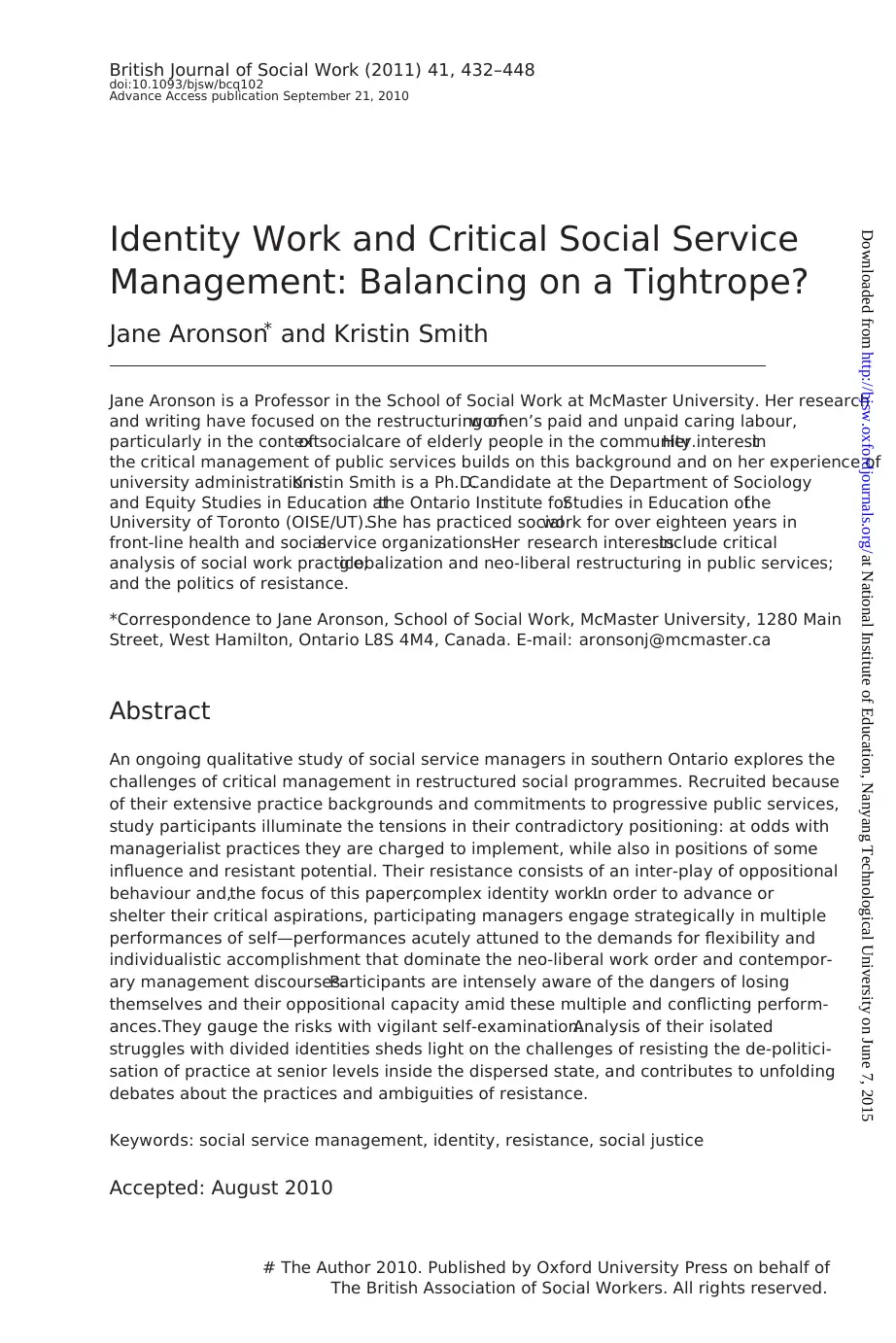
Identity Work and Critical Social Service
Management: Balancing on a Tightrope?
Jane Aronson* and Kristin Smith
Jane Aronson is a Professor in the School of Social Work at McMaster University. Her research
and writing have focused on the restructuring ofwomen’s paid and unpaid caring labour,
particularly in the contextof socialcare of elderly people in the community.Her interestin
the critical management of public services builds on this background and on her experience of
university administration.Kristin Smith is a Ph.D.Candidate at the Department of Sociology
and Equity Studies in Education atthe Ontario Institute forStudies in Education ofthe
University of Toronto (OISE/UT).She has practiced socialwork for over eighteen years in
front-line health and socialservice organizations.Her research interestsinclude critical
analysis of social work practice;globalization and neo-liberal restructuring in public services;
and the politics of resistance.
*Correspondence to Jane Aronson, School of Social Work, McMaster University, 1280 Main
Street, West Hamilton, Ontario L8S 4M4, Canada. E-mail: aronsonj@mcmaster.ca
Abstract
An ongoing qualitative study of social service managers in southern Ontario explores the
challenges of critical management in restructured social programmes. Recruited because
of their extensive practice backgrounds and commitments to progressive public services,
study participants illuminate the tensions in their contradictory positioning: at odds with
managerialist practices they are charged to implement, while also in positions of some
influence and resistant potential. Their resistance consists of an inter-play of oppositional
behaviour and,the focus of this paper,complex identity work.In order to advance or
shelter their critical aspirations, participating managers engage strategically in multiple
performances of self—performances acutely attuned to the demands for flexibility and
individualistic accomplishment that dominate the neo-liberal work order and contempor-
ary management discourses.Participants are intensely aware of the dangers of losing
themselves and their oppositional capacity amid these multiple and conflicting perform-
ances.They gauge the risks with vigilant self-examination.Analysis of their isolated
struggles with divided identities sheds light on the challenges of resisting the de-politici-
sation of practice at senior levels inside the dispersed state, and contributes to unfolding
debates about the practices and ambiguities of resistance.
Keywords: social service management, identity, resistance, social justice
Accepted: August 2010
# The Author 2010. Published by Oxford University Press on behalf of
The British Association of Social Workers. All rights reserved.
British Journal of Social Work (2011) 41, 432–448
doi:10.1093/bjsw/bcq102
Advance Access publication September 21, 2010
at National Institute of Education, Nanyang Technological University on June 7, 2015http://bjsw.oxfordjournals.org/Downloaded from
Management: Balancing on a Tightrope?
Jane Aronson* and Kristin Smith
Jane Aronson is a Professor in the School of Social Work at McMaster University. Her research
and writing have focused on the restructuring ofwomen’s paid and unpaid caring labour,
particularly in the contextof socialcare of elderly people in the community.Her interestin
the critical management of public services builds on this background and on her experience of
university administration.Kristin Smith is a Ph.D.Candidate at the Department of Sociology
and Equity Studies in Education atthe Ontario Institute forStudies in Education ofthe
University of Toronto (OISE/UT).She has practiced socialwork for over eighteen years in
front-line health and socialservice organizations.Her research interestsinclude critical
analysis of social work practice;globalization and neo-liberal restructuring in public services;
and the politics of resistance.
*Correspondence to Jane Aronson, School of Social Work, McMaster University, 1280 Main
Street, West Hamilton, Ontario L8S 4M4, Canada. E-mail: aronsonj@mcmaster.ca
Abstract
An ongoing qualitative study of social service managers in southern Ontario explores the
challenges of critical management in restructured social programmes. Recruited because
of their extensive practice backgrounds and commitments to progressive public services,
study participants illuminate the tensions in their contradictory positioning: at odds with
managerialist practices they are charged to implement, while also in positions of some
influence and resistant potential. Their resistance consists of an inter-play of oppositional
behaviour and,the focus of this paper,complex identity work.In order to advance or
shelter their critical aspirations, participating managers engage strategically in multiple
performances of self—performances acutely attuned to the demands for flexibility and
individualistic accomplishment that dominate the neo-liberal work order and contempor-
ary management discourses.Participants are intensely aware of the dangers of losing
themselves and their oppositional capacity amid these multiple and conflicting perform-
ances.They gauge the risks with vigilant self-examination.Analysis of their isolated
struggles with divided identities sheds light on the challenges of resisting the de-politici-
sation of practice at senior levels inside the dispersed state, and contributes to unfolding
debates about the practices and ambiguities of resistance.
Keywords: social service management, identity, resistance, social justice
Accepted: August 2010
# The Author 2010. Published by Oxford University Press on behalf of
The British Association of Social Workers. All rights reserved.
British Journal of Social Work (2011) 41, 432–448
doi:10.1093/bjsw/bcq102
Advance Access publication September 21, 2010
at National Institute of Education, Nanyang Technological University on June 7, 2015http://bjsw.oxfordjournals.org/Downloaded from
Secure Best Marks with AI Grader
Need help grading? Try our AI Grader for instant feedback on your assignments.
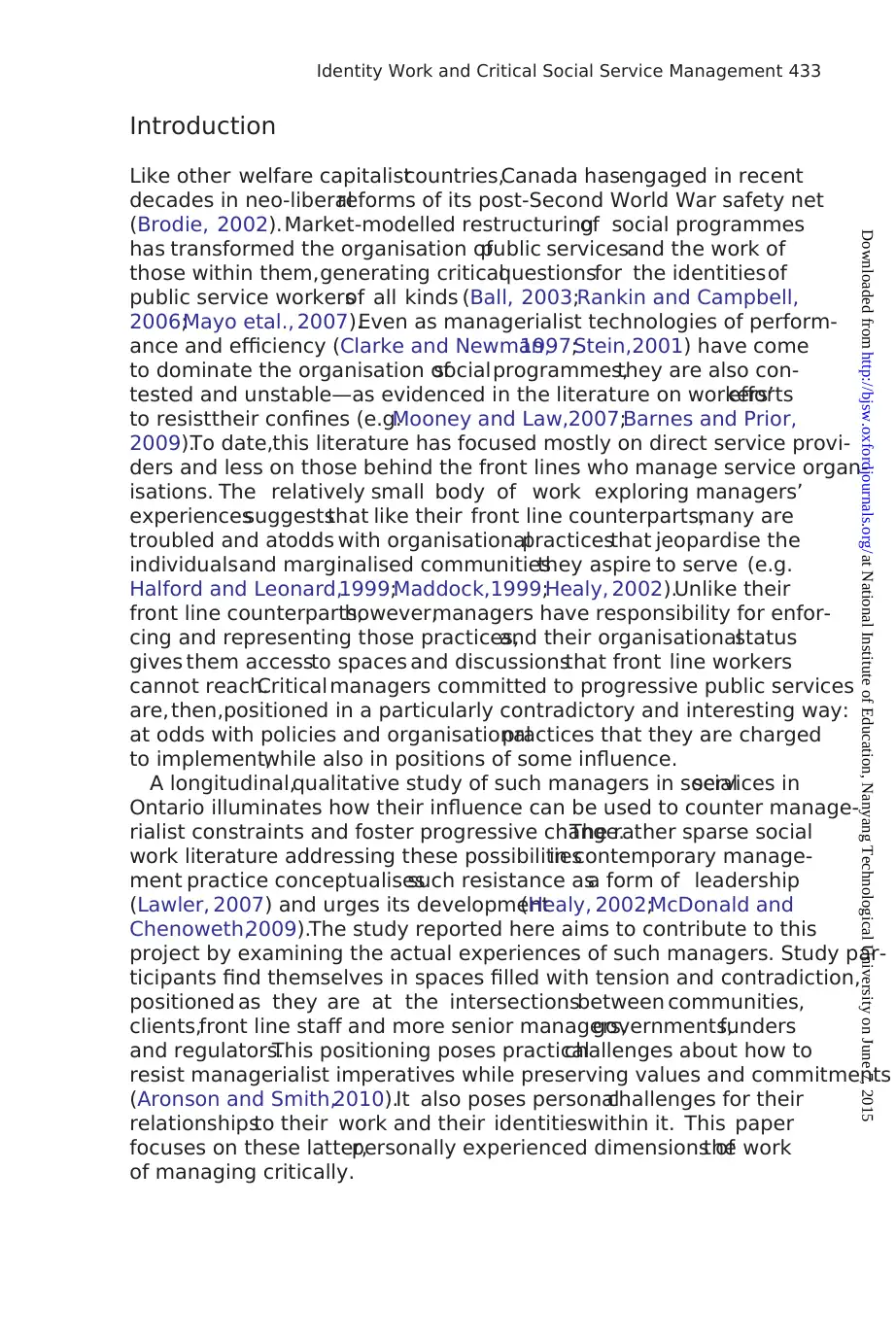
Introduction
Like other welfare capitalistcountries,Canada hasengaged in recent
decades in neo-liberalreforms of its post-Second World War safety net
(Brodie, 2002).Market-modelled restructuringof social programmes
has transformed the organisation ofpublic servicesand the work of
those within them,generating criticalquestionsfor the identitiesof
public service workersof all kinds (Ball, 2003;Rankin and Campbell,
2006;Mayo etal., 2007).Even as managerialist technologies of perform-
ance and efficiency (Clarke and Newman,1997;Stein,2001) have come
to dominate the organisation ofsocialprogrammes,they are also con-
tested and unstable—as evidenced in the literature on workers’efforts
to resisttheir confines (e.g.Mooney and Law,2007;Barnes and Prior,
2009).To date,this literature has focused mostly on direct service provi-
ders and less on those behind the front lines who manage service organ-
isations. The relatively small body of work exploring managers’
experiencessuggeststhat like their front line counterparts,many are
troubled and atodds with organisationalpracticesthat jeopardise the
individualsand marginalised communitiesthey aspire to serve (e.g.
Halford and Leonard,1999;Maddock,1999;Healy, 2002).Unlike their
front line counterparts,however,managers have responsibility for enfor-
cing and representing those practices,and their organisationalstatus
gives them accessto spaces and discussionsthat front line workers
cannot reach.Critical managers committed to progressive public services
are,then,positioned in a particularly contradictory and interesting way:
at odds with policies and organisationalpractices that they are charged
to implement,while also in positions of some influence.
A longitudinal,qualitative study of such managers in socialservices in
Ontario illuminates how their influence can be used to counter manage-
rialist constraints and foster progressive change.The rather sparse social
work literature addressing these possibilitiesin contemporary manage-
ment practice conceptualisessuch resistance asa form of leadership
(Lawler, 2007) and urges its development(Healy, 2002;McDonald and
Chenoweth,2009).The study reported here aims to contribute to this
project by examining the actual experiences of such managers. Study par-
ticipants find themselves in spaces filled with tension and contradiction,
positioned as they are at the intersectionsbetween communities,
clients,front line staff and more senior managers,governments,funders
and regulators.This positioning poses practicalchallenges about how to
resist managerialist imperatives while preserving values and commitments
(Aronson and Smith,2010).It also poses personalchallenges for their
relationshipsto their work and their identitieswithin it. This paper
focuses on these latter,personally experienced dimensions ofthe work
of managing critically.
Identity Work and Critical Social Service Management 433
at National Institute of Education, Nanyang Technological University on June 7, 2015http://bjsw.oxfordjournals.org/Downloaded from
Like other welfare capitalistcountries,Canada hasengaged in recent
decades in neo-liberalreforms of its post-Second World War safety net
(Brodie, 2002).Market-modelled restructuringof social programmes
has transformed the organisation ofpublic servicesand the work of
those within them,generating criticalquestionsfor the identitiesof
public service workersof all kinds (Ball, 2003;Rankin and Campbell,
2006;Mayo etal., 2007).Even as managerialist technologies of perform-
ance and efficiency (Clarke and Newman,1997;Stein,2001) have come
to dominate the organisation ofsocialprogrammes,they are also con-
tested and unstable—as evidenced in the literature on workers’efforts
to resisttheir confines (e.g.Mooney and Law,2007;Barnes and Prior,
2009).To date,this literature has focused mostly on direct service provi-
ders and less on those behind the front lines who manage service organ-
isations. The relatively small body of work exploring managers’
experiencessuggeststhat like their front line counterparts,many are
troubled and atodds with organisationalpracticesthat jeopardise the
individualsand marginalised communitiesthey aspire to serve (e.g.
Halford and Leonard,1999;Maddock,1999;Healy, 2002).Unlike their
front line counterparts,however,managers have responsibility for enfor-
cing and representing those practices,and their organisationalstatus
gives them accessto spaces and discussionsthat front line workers
cannot reach.Critical managers committed to progressive public services
are,then,positioned in a particularly contradictory and interesting way:
at odds with policies and organisationalpractices that they are charged
to implement,while also in positions of some influence.
A longitudinal,qualitative study of such managers in socialservices in
Ontario illuminates how their influence can be used to counter manage-
rialist constraints and foster progressive change.The rather sparse social
work literature addressing these possibilitiesin contemporary manage-
ment practice conceptualisessuch resistance asa form of leadership
(Lawler, 2007) and urges its development(Healy, 2002;McDonald and
Chenoweth,2009).The study reported here aims to contribute to this
project by examining the actual experiences of such managers. Study par-
ticipants find themselves in spaces filled with tension and contradiction,
positioned as they are at the intersectionsbetween communities,
clients,front line staff and more senior managers,governments,funders
and regulators.This positioning poses practicalchallenges about how to
resist managerialist imperatives while preserving values and commitments
(Aronson and Smith,2010).It also poses personalchallenges for their
relationshipsto their work and their identitieswithin it. This paper
focuses on these latter,personally experienced dimensions ofthe work
of managing critically.
Identity Work and Critical Social Service Management 433
at National Institute of Education, Nanyang Technological University on June 7, 2015http://bjsw.oxfordjournals.org/Downloaded from
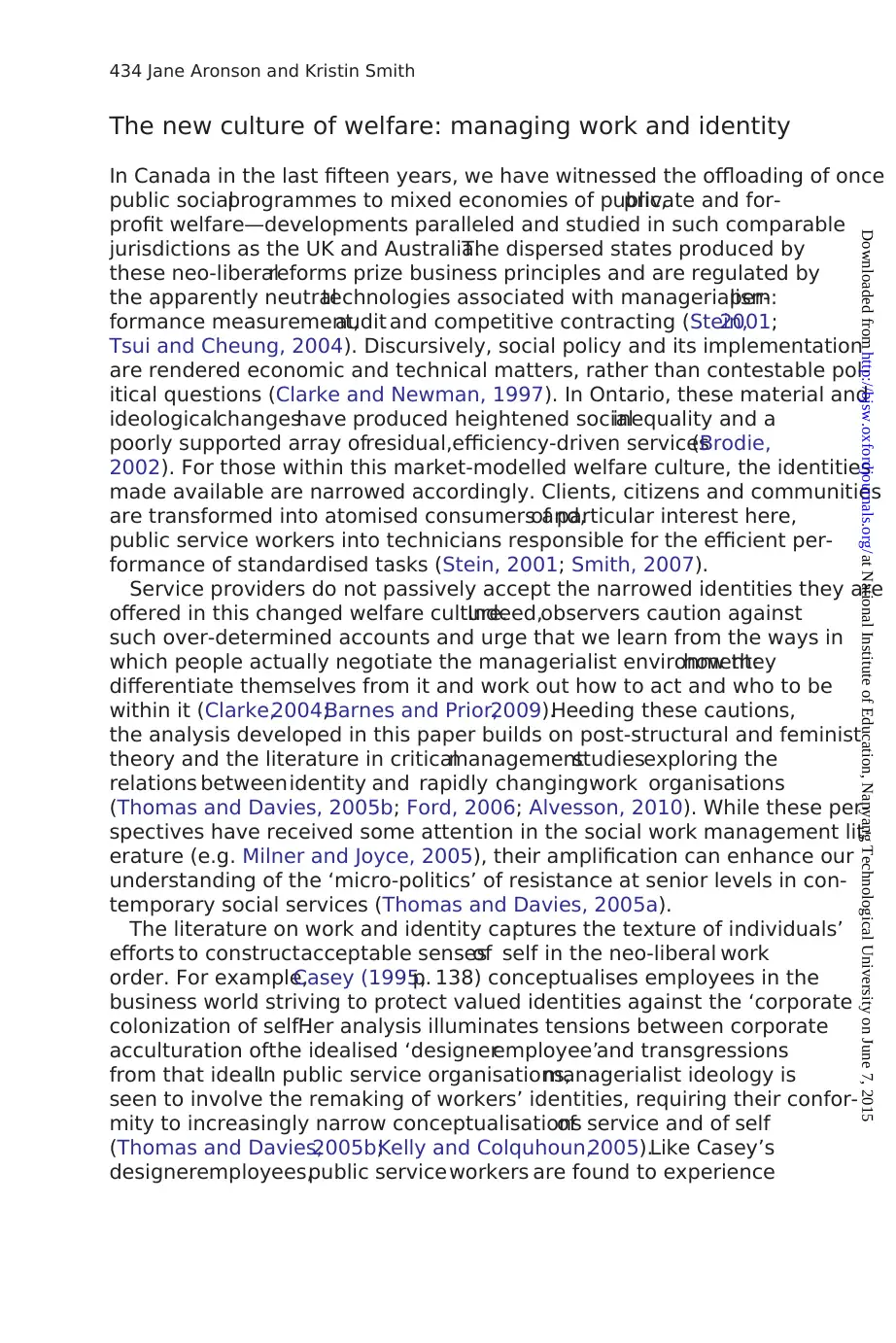
The new culture of welfare: managing work and identity
In Canada in the last fifteen years, we have witnessed the offloading of once
public socialprogrammes to mixed economies of public,private and for-
profit welfare—developments paralleled and studied in such comparable
jurisdictions as the UK and Australia.The dispersed states produced by
these neo-liberalreforms prize business principles and are regulated by
the apparently neutraltechnologies associated with managerialism:per-
formance measurement,audit and competitive contracting (Stein,2001;
Tsui and Cheung, 2004). Discursively, social policy and its implementation
are rendered economic and technical matters, rather than contestable pol-
itical questions (Clarke and Newman, 1997). In Ontario, these material and
ideologicalchangeshave produced heightened socialinequality and a
poorly supported array ofresidual,efficiency-driven services(Brodie,
2002). For those within this market-modelled welfare culture, the identities
made available are narrowed accordingly. Clients, citizens and communities
are transformed into atomised consumers and,of particular interest here,
public service workers into technicians responsible for the efficient per-
formance of standardised tasks (Stein, 2001; Smith, 2007).
Service providers do not passively accept the narrowed identities they are
offered in this changed welfare culture.Indeed,observers caution against
such over-determined accounts and urge that we learn from the ways in
which people actually negotiate the managerialist environment:how they
differentiate themselves from it and work out how to act and who to be
within it (Clarke,2004;Barnes and Prior,2009).Heeding these cautions,
the analysis developed in this paper builds on post-structural and feminist
theory and the literature in criticalmanagementstudiesexploring the
relations betweenidentity and rapidly changingwork organisations
(Thomas and Davies, 2005b; Ford, 2006; Alvesson, 2010). While these per-
spectives have received some attention in the social work management lit-
erature (e.g. Milner and Joyce, 2005), their amplification can enhance our
understanding of the ‘micro-politics’ of resistance at senior levels in con-
temporary social services (Thomas and Davies, 2005a).
The literature on work and identity captures the texture of individuals’
efforts to constructacceptable sensesof self in the neo-liberal work
order. For example,Casey (1995,p. 138) conceptualises employees in the
business world striving to protect valued identities against the ‘corporate
colonization of self’.Her analysis illuminates tensions between corporate
acculturation ofthe idealised ‘designeremployee’and transgressions
from that ideal.In public service organisations,managerialist ideology is
seen to involve the remaking of workers’ identities, requiring their confor-
mity to increasingly narrow conceptualisationsof service and of self
(Thomas and Davies,2005b;Kelly and Colquhoun,2005).Like Casey’s
designeremployees,public serviceworkers are found to experience
434 Jane Aronson and Kristin Smith
at National Institute of Education, Nanyang Technological University on June 7, 2015http://bjsw.oxfordjournals.org/Downloaded from
In Canada in the last fifteen years, we have witnessed the offloading of once
public socialprogrammes to mixed economies of public,private and for-
profit welfare—developments paralleled and studied in such comparable
jurisdictions as the UK and Australia.The dispersed states produced by
these neo-liberalreforms prize business principles and are regulated by
the apparently neutraltechnologies associated with managerialism:per-
formance measurement,audit and competitive contracting (Stein,2001;
Tsui and Cheung, 2004). Discursively, social policy and its implementation
are rendered economic and technical matters, rather than contestable pol-
itical questions (Clarke and Newman, 1997). In Ontario, these material and
ideologicalchangeshave produced heightened socialinequality and a
poorly supported array ofresidual,efficiency-driven services(Brodie,
2002). For those within this market-modelled welfare culture, the identities
made available are narrowed accordingly. Clients, citizens and communities
are transformed into atomised consumers and,of particular interest here,
public service workers into technicians responsible for the efficient per-
formance of standardised tasks (Stein, 2001; Smith, 2007).
Service providers do not passively accept the narrowed identities they are
offered in this changed welfare culture.Indeed,observers caution against
such over-determined accounts and urge that we learn from the ways in
which people actually negotiate the managerialist environment:how they
differentiate themselves from it and work out how to act and who to be
within it (Clarke,2004;Barnes and Prior,2009).Heeding these cautions,
the analysis developed in this paper builds on post-structural and feminist
theory and the literature in criticalmanagementstudiesexploring the
relations betweenidentity and rapidly changingwork organisations
(Thomas and Davies, 2005b; Ford, 2006; Alvesson, 2010). While these per-
spectives have received some attention in the social work management lit-
erature (e.g. Milner and Joyce, 2005), their amplification can enhance our
understanding of the ‘micro-politics’ of resistance at senior levels in con-
temporary social services (Thomas and Davies, 2005a).
The literature on work and identity captures the texture of individuals’
efforts to constructacceptable sensesof self in the neo-liberal work
order. For example,Casey (1995,p. 138) conceptualises employees in the
business world striving to protect valued identities against the ‘corporate
colonization of self’.Her analysis illuminates tensions between corporate
acculturation ofthe idealised ‘designeremployee’and transgressions
from that ideal.In public service organisations,managerialist ideology is
seen to involve the remaking of workers’ identities, requiring their confor-
mity to increasingly narrow conceptualisationsof service and of self
(Thomas and Davies,2005b;Kelly and Colquhoun,2005).Like Casey’s
designeremployees,public serviceworkers are found to experience
434 Jane Aronson and Kristin Smith
at National Institute of Education, Nanyang Technological University on June 7, 2015http://bjsw.oxfordjournals.org/Downloaded from
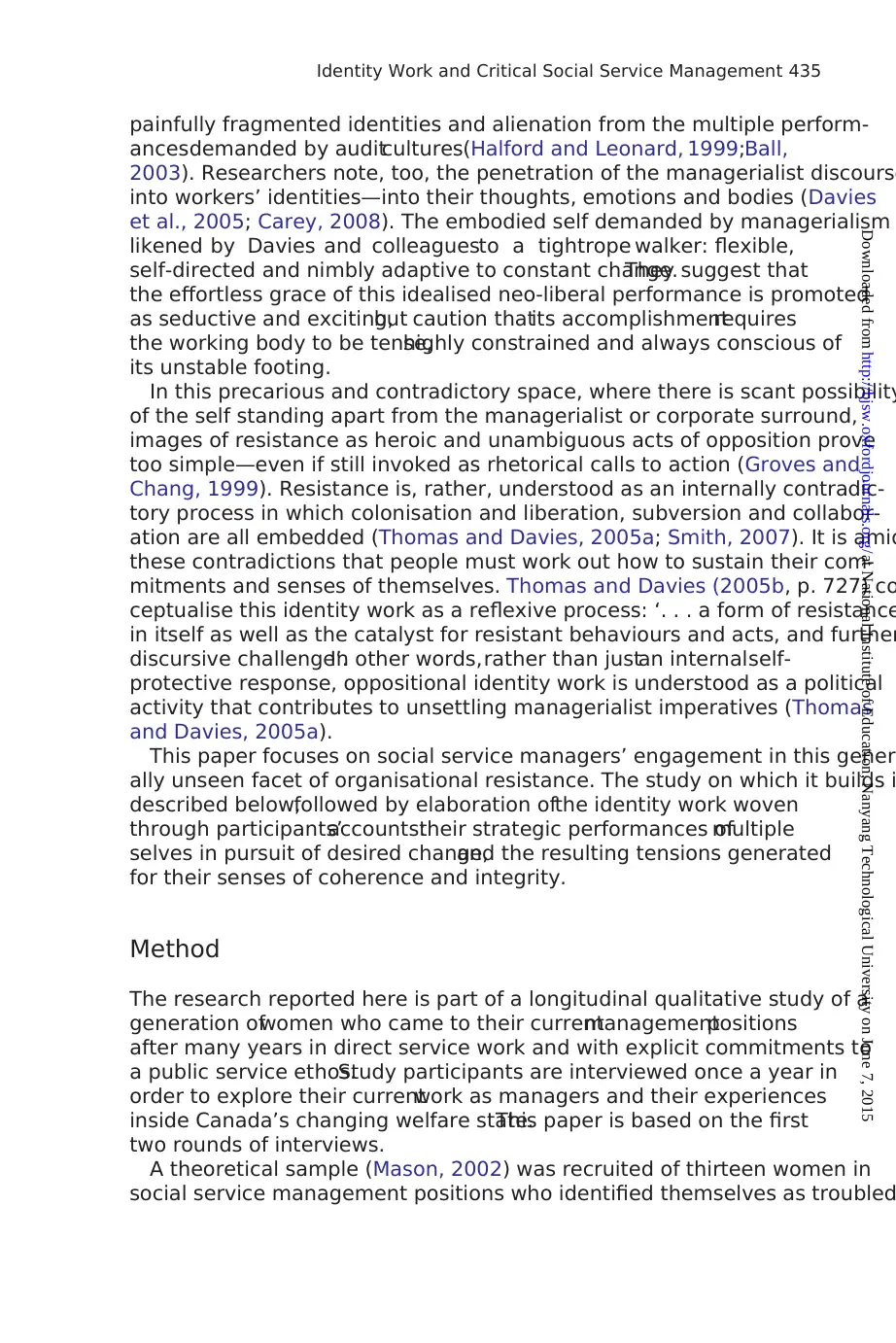
painfully fragmented identities and alienation from the multiple perform-
ancesdemanded by auditcultures(Halford and Leonard, 1999;Ball,
2003). Researchers note, too, the penetration of the managerialist discourse
into workers’ identities—into their thoughts, emotions and bodies (Davies
et al., 2005; Carey, 2008). The embodied self demanded by managerialism
likened by Davies and colleaguesto a tightrope walker: flexible,
self-directed and nimbly adaptive to constant change.They suggest that
the effortless grace of this idealised neo-liberal performance is promoted
as seductive and exciting,but caution thatits accomplishmentrequires
the working body to be tense,highly constrained and always conscious of
its unstable footing.
In this precarious and contradictory space, where there is scant possibility
of the self standing apart from the managerialist or corporate surround,
images of resistance as heroic and unambiguous acts of opposition prove
too simple—even if still invoked as rhetorical calls to action (Groves and
Chang, 1999). Resistance is, rather, understood as an internally contradic-
tory process in which colonisation and liberation, subversion and collabor-
ation are all embedded (Thomas and Davies, 2005a; Smith, 2007). It is amid
these contradictions that people must work out how to sustain their com-
mitments and senses of themselves. Thomas and Davies (2005b, p. 727) co
ceptualise this identity work as a reflexive process: ‘. . . a form of resistance
in itself as well as the catalyst for resistant behaviours and acts, and further
discursive challenge’.In other words,rather than justan internalself-
protective response, oppositional identity work is understood as a political
activity that contributes to unsettling managerialist imperatives (Thomas
and Davies, 2005a).
This paper focuses on social service managers’ engagement in this gener
ally unseen facet of organisational resistance. The study on which it builds i
described below,followed by elaboration ofthe identity work woven
through participants’accounts:their strategic performances ofmultiple
selves in pursuit of desired change,and the resulting tensions generated
for their senses of coherence and integrity.
Method
The research reported here is part of a longitudinal qualitative study of a
generation ofwomen who came to their currentmanagementpositions
after many years in direct service work and with explicit commitments to
a public service ethos.Study participants are interviewed once a year in
order to explore their currentwork as managers and their experiences
inside Canada’s changing welfare state.This paper is based on the first
two rounds of interviews.
A theoretical sample (Mason, 2002) was recruited of thirteen women in
social service management positions who identified themselves as troubled
Identity Work and Critical Social Service Management 435
at National Institute of Education, Nanyang Technological University on June 7, 2015http://bjsw.oxfordjournals.org/Downloaded from
ancesdemanded by auditcultures(Halford and Leonard, 1999;Ball,
2003). Researchers note, too, the penetration of the managerialist discourse
into workers’ identities—into their thoughts, emotions and bodies (Davies
et al., 2005; Carey, 2008). The embodied self demanded by managerialism
likened by Davies and colleaguesto a tightrope walker: flexible,
self-directed and nimbly adaptive to constant change.They suggest that
the effortless grace of this idealised neo-liberal performance is promoted
as seductive and exciting,but caution thatits accomplishmentrequires
the working body to be tense,highly constrained and always conscious of
its unstable footing.
In this precarious and contradictory space, where there is scant possibility
of the self standing apart from the managerialist or corporate surround,
images of resistance as heroic and unambiguous acts of opposition prove
too simple—even if still invoked as rhetorical calls to action (Groves and
Chang, 1999). Resistance is, rather, understood as an internally contradic-
tory process in which colonisation and liberation, subversion and collabor-
ation are all embedded (Thomas and Davies, 2005a; Smith, 2007). It is amid
these contradictions that people must work out how to sustain their com-
mitments and senses of themselves. Thomas and Davies (2005b, p. 727) co
ceptualise this identity work as a reflexive process: ‘. . . a form of resistance
in itself as well as the catalyst for resistant behaviours and acts, and further
discursive challenge’.In other words,rather than justan internalself-
protective response, oppositional identity work is understood as a political
activity that contributes to unsettling managerialist imperatives (Thomas
and Davies, 2005a).
This paper focuses on social service managers’ engagement in this gener
ally unseen facet of organisational resistance. The study on which it builds i
described below,followed by elaboration ofthe identity work woven
through participants’accounts:their strategic performances ofmultiple
selves in pursuit of desired change,and the resulting tensions generated
for their senses of coherence and integrity.
Method
The research reported here is part of a longitudinal qualitative study of a
generation ofwomen who came to their currentmanagementpositions
after many years in direct service work and with explicit commitments to
a public service ethos.Study participants are interviewed once a year in
order to explore their currentwork as managers and their experiences
inside Canada’s changing welfare state.This paper is based on the first
two rounds of interviews.
A theoretical sample (Mason, 2002) was recruited of thirteen women in
social service management positions who identified themselves as troubled
Identity Work and Critical Social Service Management 435
at National Institute of Education, Nanyang Technological University on June 7, 2015http://bjsw.oxfordjournals.org/Downloaded from
Secure Best Marks with AI Grader
Need help grading? Try our AI Grader for instant feedback on your assignments.
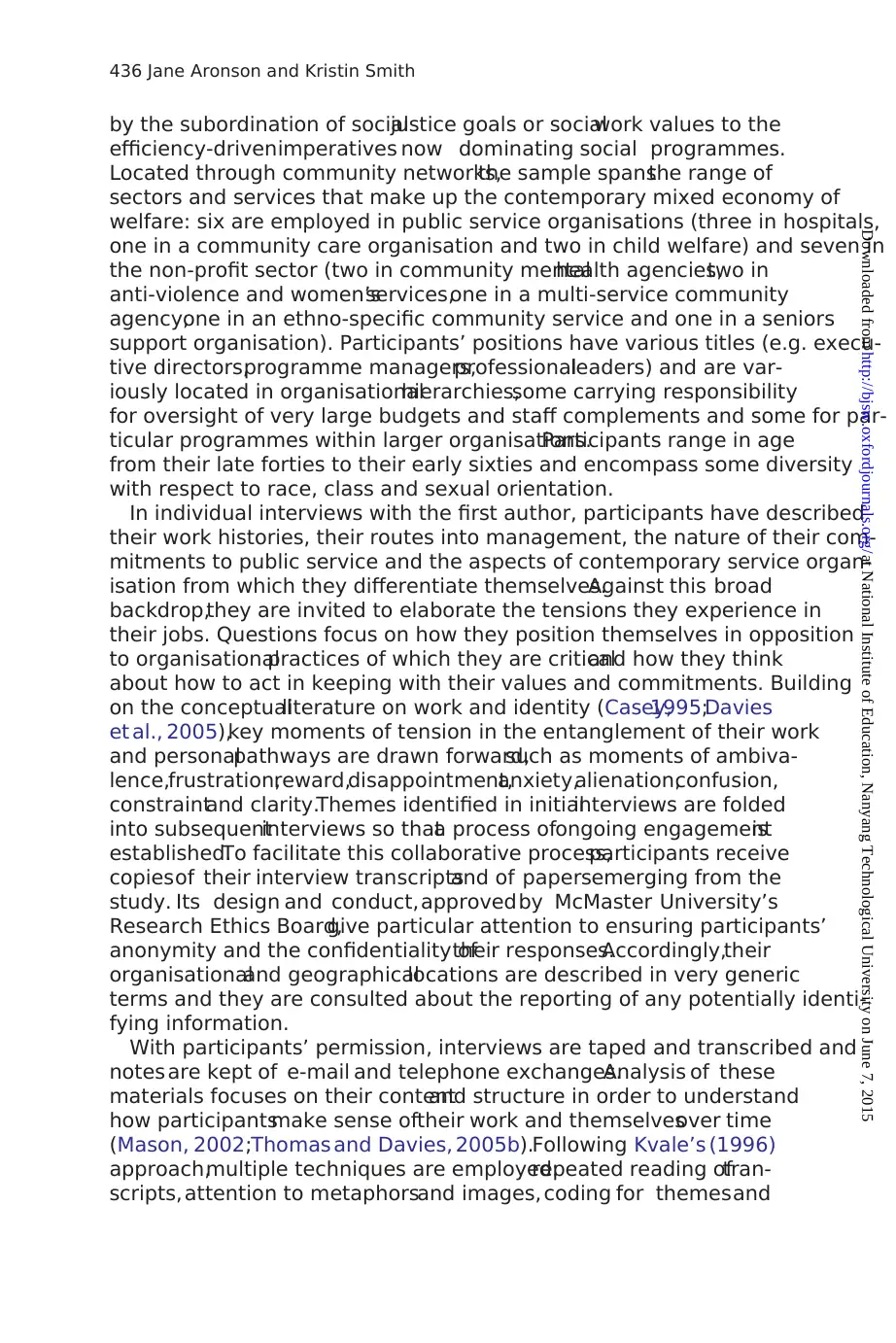
by the subordination of socialjustice goals or socialwork values to the
efficiency-drivenimperatives now dominating social programmes.
Located through community networks,the sample spansthe range of
sectors and services that make up the contemporary mixed economy of
welfare: six are employed in public service organisations (three in hospitals,
one in a community care organisation and two in child welfare) and seven in
the non-profit sector (two in community mentalhealth agencies,two in
anti-violence and women’sservices,one in a multi-service community
agency,one in an ethno-specific community service and one in a seniors
support organisation). Participants’ positions have various titles (e.g. execu-
tive directors,programme managers,professionalleaders) and are var-
iously located in organisationalhierarchies,some carrying responsibility
for oversight of very large budgets and staff complements and some for par-
ticular programmes within larger organisations.Participants range in age
from their late forties to their early sixties and encompass some diversity
with respect to race, class and sexual orientation.
In individual interviews with the first author, participants have described
their work histories, their routes into management, the nature of their com-
mitments to public service and the aspects of contemporary service organ-
isation from which they differentiate themselves.Against this broad
backdrop,they are invited to elaborate the tensions they experience in
their jobs. Questions focus on how they position themselves in opposition
to organisationalpractices of which they are criticaland how they think
about how to act in keeping with their values and commitments. Building
on the conceptualliterature on work and identity (Casey,1995;Davies
et al., 2005),key moments of tension in the entanglement of their work
and personalpathways are drawn forward,such as moments of ambiva-
lence,frustration,reward,disappointment,anxiety,alienation,confusion,
constraintand clarity.Themes identified in initialinterviews are folded
into subsequentinterviews so thata process ofongoing engagementis
established.To facilitate this collaborative process,participants receive
copiesof their interview transcriptsand of papersemerging from the
study. Its design and conduct,approvedby McMaster University’s
Research Ethics Board,give particular attention to ensuring participants’
anonymity and the confidentiality oftheir responses.Accordingly,their
organisationaland geographicallocations are described in very generic
terms and they are consulted about the reporting of any potentially identi-
fying information.
With participants’ permission, interviews are taped and transcribed and
notes are kept of e-mail and telephone exchanges.Analysis of these
materials focuses on their contentand structure in order to understand
how participantsmake sense oftheir work and themselvesover time
(Mason, 2002;Thomas and Davies, 2005b).Following Kvale’s (1996)
approach,multiple techniques are employed:repeated reading oftran-
scripts, attention to metaphorsand images, coding for themesand
436 Jane Aronson and Kristin Smith
at National Institute of Education, Nanyang Technological University on June 7, 2015http://bjsw.oxfordjournals.org/Downloaded from
efficiency-drivenimperatives now dominating social programmes.
Located through community networks,the sample spansthe range of
sectors and services that make up the contemporary mixed economy of
welfare: six are employed in public service organisations (three in hospitals,
one in a community care organisation and two in child welfare) and seven in
the non-profit sector (two in community mentalhealth agencies,two in
anti-violence and women’sservices,one in a multi-service community
agency,one in an ethno-specific community service and one in a seniors
support organisation). Participants’ positions have various titles (e.g. execu-
tive directors,programme managers,professionalleaders) and are var-
iously located in organisationalhierarchies,some carrying responsibility
for oversight of very large budgets and staff complements and some for par-
ticular programmes within larger organisations.Participants range in age
from their late forties to their early sixties and encompass some diversity
with respect to race, class and sexual orientation.
In individual interviews with the first author, participants have described
their work histories, their routes into management, the nature of their com-
mitments to public service and the aspects of contemporary service organ-
isation from which they differentiate themselves.Against this broad
backdrop,they are invited to elaborate the tensions they experience in
their jobs. Questions focus on how they position themselves in opposition
to organisationalpractices of which they are criticaland how they think
about how to act in keeping with their values and commitments. Building
on the conceptualliterature on work and identity (Casey,1995;Davies
et al., 2005),key moments of tension in the entanglement of their work
and personalpathways are drawn forward,such as moments of ambiva-
lence,frustration,reward,disappointment,anxiety,alienation,confusion,
constraintand clarity.Themes identified in initialinterviews are folded
into subsequentinterviews so thata process ofongoing engagementis
established.To facilitate this collaborative process,participants receive
copiesof their interview transcriptsand of papersemerging from the
study. Its design and conduct,approvedby McMaster University’s
Research Ethics Board,give particular attention to ensuring participants’
anonymity and the confidentiality oftheir responses.Accordingly,their
organisationaland geographicallocations are described in very generic
terms and they are consulted about the reporting of any potentially identi-
fying information.
With participants’ permission, interviews are taped and transcribed and
notes are kept of e-mail and telephone exchanges.Analysis of these
materials focuses on their contentand structure in order to understand
how participantsmake sense oftheir work and themselvesover time
(Mason, 2002;Thomas and Davies, 2005b).Following Kvale’s (1996)
approach,multiple techniques are employed:repeated reading oftran-
scripts, attention to metaphorsand images, coding for themesand
436 Jane Aronson and Kristin Smith
at National Institute of Education, Nanyang Technological University on June 7, 2015http://bjsw.oxfordjournals.org/Downloaded from
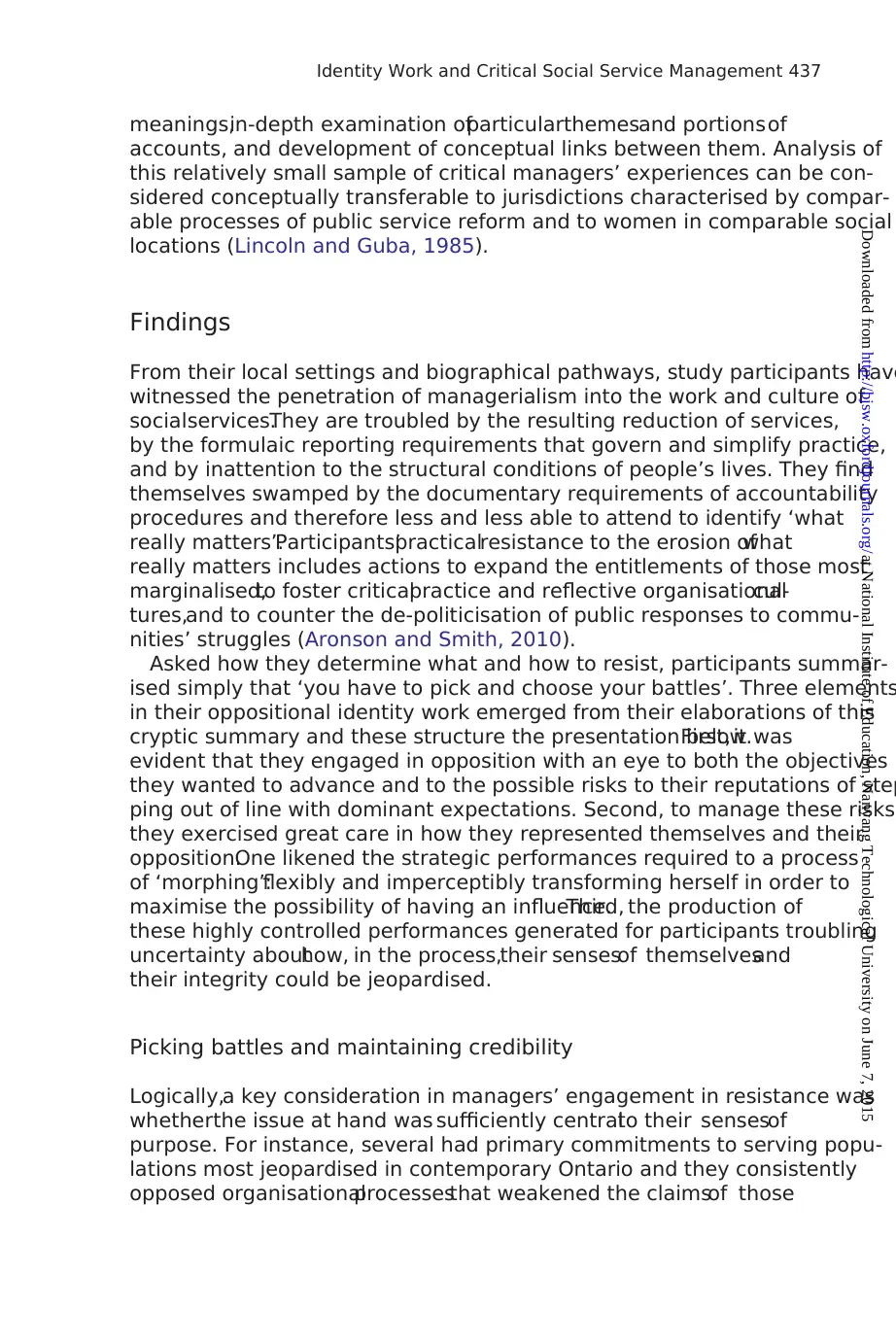
meanings,in-depth examination ofparticularthemesand portionsof
accounts, and development of conceptual links between them. Analysis of
this relatively small sample of critical managers’ experiences can be con-
sidered conceptually transferable to jurisdictions characterised by compar-
able processes of public service reform and to women in comparable social
locations (Lincoln and Guba, 1985).
Findings
From their local settings and biographical pathways, study participants have
witnessed the penetration of managerialism into the work and culture of
socialservices.They are troubled by the resulting reduction of services,
by the formulaic reporting requirements that govern and simplify practice,
and by inattention to the structural conditions of people’s lives. They find
themselves swamped by the documentary requirements of accountability
procedures and therefore less and less able to attend to identify ‘what
really matters’.Participants’practicalresistance to the erosion ofwhat
really matters includes actions to expand the entitlements of those most
marginalised,to foster criticalpractice and reflective organisationalcul-
tures,and to counter the de-politicisation of public responses to commu-
nities’ struggles (Aronson and Smith, 2010).
Asked how they determine what and how to resist, participants summar-
ised simply that ‘you have to pick and choose your battles’. Three elements
in their oppositional identity work emerged from their elaborations of this
cryptic summary and these structure the presentation below.First, it was
evident that they engaged in opposition with an eye to both the objectives
they wanted to advance and to the possible risks to their reputations of step
ping out of line with dominant expectations. Second, to manage these risks,
they exercised great care in how they represented themselves and their
opposition.One likened the strategic performances required to a process
of ‘morphing’:flexibly and imperceptibly transforming herself in order to
maximise the possibility of having an influence.Third, the production of
these highly controlled performances generated for participants troubling
uncertainty abouthow, in the process,their sensesof themselvesand
their integrity could be jeopardised.
Picking battles and maintaining credibility
Logically,a key consideration in managers’ engagement in resistance was
whetherthe issue at hand was sufficiently centralto their sensesof
purpose. For instance, several had primary commitments to serving popu-
lations most jeopardised in contemporary Ontario and they consistently
opposed organisationalprocessesthat weakened the claimsof those
Identity Work and Critical Social Service Management 437
at National Institute of Education, Nanyang Technological University on June 7, 2015http://bjsw.oxfordjournals.org/Downloaded from
accounts, and development of conceptual links between them. Analysis of
this relatively small sample of critical managers’ experiences can be con-
sidered conceptually transferable to jurisdictions characterised by compar-
able processes of public service reform and to women in comparable social
locations (Lincoln and Guba, 1985).
Findings
From their local settings and biographical pathways, study participants have
witnessed the penetration of managerialism into the work and culture of
socialservices.They are troubled by the resulting reduction of services,
by the formulaic reporting requirements that govern and simplify practice,
and by inattention to the structural conditions of people’s lives. They find
themselves swamped by the documentary requirements of accountability
procedures and therefore less and less able to attend to identify ‘what
really matters’.Participants’practicalresistance to the erosion ofwhat
really matters includes actions to expand the entitlements of those most
marginalised,to foster criticalpractice and reflective organisationalcul-
tures,and to counter the de-politicisation of public responses to commu-
nities’ struggles (Aronson and Smith, 2010).
Asked how they determine what and how to resist, participants summar-
ised simply that ‘you have to pick and choose your battles’. Three elements
in their oppositional identity work emerged from their elaborations of this
cryptic summary and these structure the presentation below.First, it was
evident that they engaged in opposition with an eye to both the objectives
they wanted to advance and to the possible risks to their reputations of step
ping out of line with dominant expectations. Second, to manage these risks,
they exercised great care in how they represented themselves and their
opposition.One likened the strategic performances required to a process
of ‘morphing’:flexibly and imperceptibly transforming herself in order to
maximise the possibility of having an influence.Third, the production of
these highly controlled performances generated for participants troubling
uncertainty abouthow, in the process,their sensesof themselvesand
their integrity could be jeopardised.
Picking battles and maintaining credibility
Logically,a key consideration in managers’ engagement in resistance was
whetherthe issue at hand was sufficiently centralto their sensesof
purpose. For instance, several had primary commitments to serving popu-
lations most jeopardised in contemporary Ontario and they consistently
opposed organisationalprocessesthat weakened the claimsof those
Identity Work and Critical Social Service Management 437
at National Institute of Education, Nanyang Technological University on June 7, 2015http://bjsw.oxfordjournals.org/Downloaded from
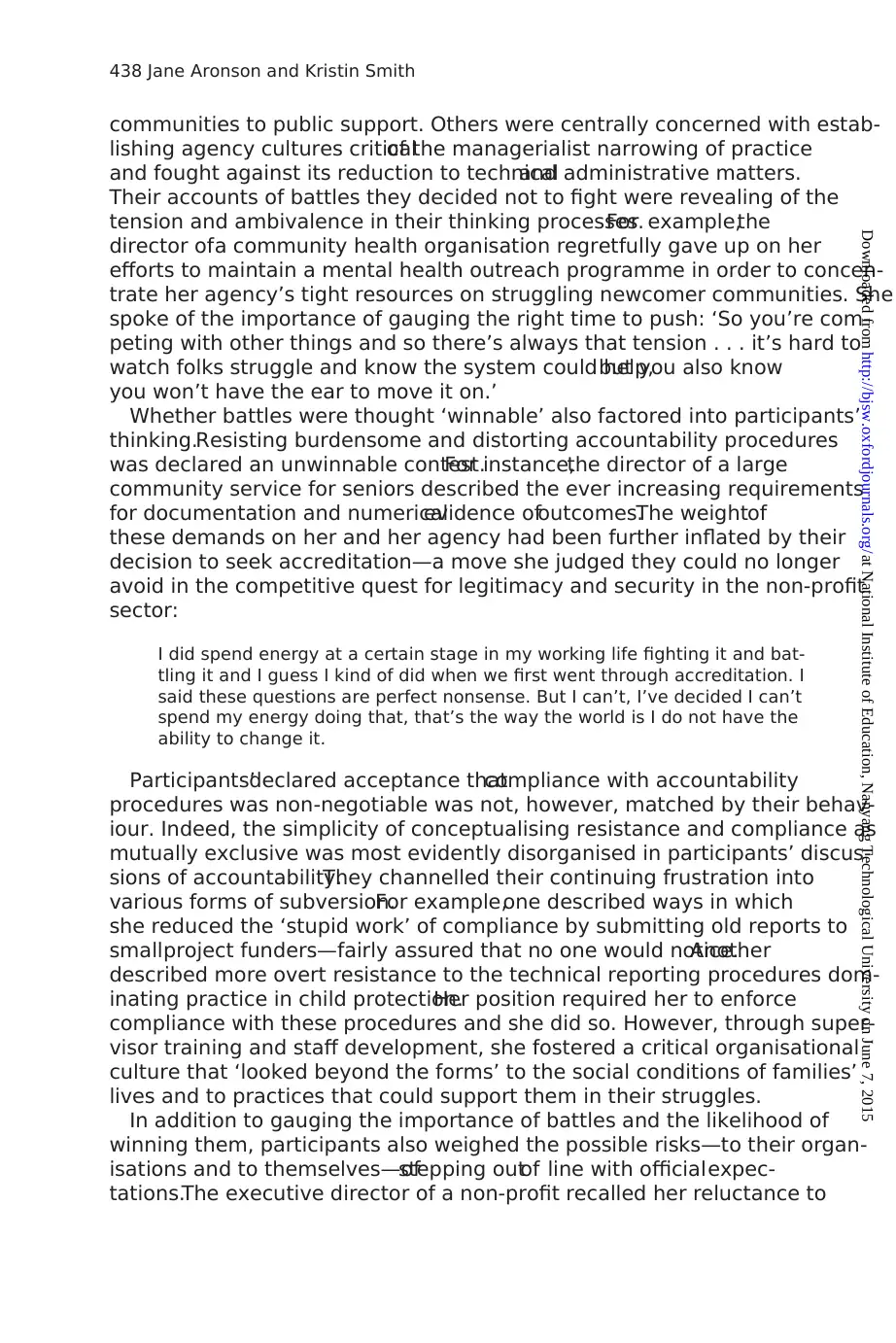
communities to public support. Others were centrally concerned with estab-
lishing agency cultures criticalof the managerialist narrowing of practice
and fought against its reduction to technicaland administrative matters.
Their accounts of battles they decided not to fight were revealing of the
tension and ambivalence in their thinking processes.For example,the
director ofa community health organisation regretfully gave up on her
efforts to maintain a mental health outreach programme in order to concen-
trate her agency’s tight resources on struggling newcomer communities. She
spoke of the importance of gauging the right time to push: ‘So you’re com-
peting with other things and so there’s always that tension . . . it’s hard to
watch folks struggle and know the system could help,but you also know
you won’t have the ear to move it on.’
Whether battles were thought ‘winnable’ also factored into participants’
thinking.Resisting burdensome and distorting accountability procedures
was declared an unwinnable contest.For instance,the director of a large
community service for seniors described the ever increasing requirements
for documentation and numericalevidence ofoutcomes.The weightof
these demands on her and her agency had been further inflated by their
decision to seek accreditation—a move she judged they could no longer
avoid in the competitive quest for legitimacy and security in the non-profit
sector:
I did spend energy at a certain stage in my working life fighting it and bat-
tling it and I guess I kind of did when we first went through accreditation. I
said these questions are perfect nonsense. But I can’t, I’ve decided I can’t
spend my energy doing that, that’s the way the world is I do not have the
ability to change it.
Participants’declared acceptance thatcompliance with accountability
procedures was non-negotiable was not, however, matched by their behav-
iour. Indeed, the simplicity of conceptualising resistance and compliance as
mutually exclusive was most evidently disorganised in participants’ discus-
sions of accountability.They channelled their continuing frustration into
various forms of subversion.For example,one described ways in which
she reduced the ‘stupid work’ of compliance by submitting old reports to
smallproject funders—fairly assured that no one would notice.Another
described more overt resistance to the technical reporting procedures dom-
inating practice in child protection.Her position required her to enforce
compliance with these procedures and she did so. However, through super-
visor training and staff development, she fostered a critical organisational
culture that ‘looked beyond the forms’ to the social conditions of families’
lives and to practices that could support them in their struggles.
In addition to gauging the importance of battles and the likelihood of
winning them, participants also weighed the possible risks—to their organ-
isations and to themselves—ofstepping outof line with officialexpec-
tations.The executive director of a non-profit recalled her reluctance to
438 Jane Aronson and Kristin Smith
at National Institute of Education, Nanyang Technological University on June 7, 2015http://bjsw.oxfordjournals.org/Downloaded from
lishing agency cultures criticalof the managerialist narrowing of practice
and fought against its reduction to technicaland administrative matters.
Their accounts of battles they decided not to fight were revealing of the
tension and ambivalence in their thinking processes.For example,the
director ofa community health organisation regretfully gave up on her
efforts to maintain a mental health outreach programme in order to concen-
trate her agency’s tight resources on struggling newcomer communities. She
spoke of the importance of gauging the right time to push: ‘So you’re com-
peting with other things and so there’s always that tension . . . it’s hard to
watch folks struggle and know the system could help,but you also know
you won’t have the ear to move it on.’
Whether battles were thought ‘winnable’ also factored into participants’
thinking.Resisting burdensome and distorting accountability procedures
was declared an unwinnable contest.For instance,the director of a large
community service for seniors described the ever increasing requirements
for documentation and numericalevidence ofoutcomes.The weightof
these demands on her and her agency had been further inflated by their
decision to seek accreditation—a move she judged they could no longer
avoid in the competitive quest for legitimacy and security in the non-profit
sector:
I did spend energy at a certain stage in my working life fighting it and bat-
tling it and I guess I kind of did when we first went through accreditation. I
said these questions are perfect nonsense. But I can’t, I’ve decided I can’t
spend my energy doing that, that’s the way the world is I do not have the
ability to change it.
Participants’declared acceptance thatcompliance with accountability
procedures was non-negotiable was not, however, matched by their behav-
iour. Indeed, the simplicity of conceptualising resistance and compliance as
mutually exclusive was most evidently disorganised in participants’ discus-
sions of accountability.They channelled their continuing frustration into
various forms of subversion.For example,one described ways in which
she reduced the ‘stupid work’ of compliance by submitting old reports to
smallproject funders—fairly assured that no one would notice.Another
described more overt resistance to the technical reporting procedures dom-
inating practice in child protection.Her position required her to enforce
compliance with these procedures and she did so. However, through super-
visor training and staff development, she fostered a critical organisational
culture that ‘looked beyond the forms’ to the social conditions of families’
lives and to practices that could support them in their struggles.
In addition to gauging the importance of battles and the likelihood of
winning them, participants also weighed the possible risks—to their organ-
isations and to themselves—ofstepping outof line with officialexpec-
tations.The executive director of a non-profit recalled her reluctance to
438 Jane Aronson and Kristin Smith
at National Institute of Education, Nanyang Technological University on June 7, 2015http://bjsw.oxfordjournals.org/Downloaded from
Paraphrase This Document
Need a fresh take? Get an instant paraphrase of this document with our AI Paraphraser
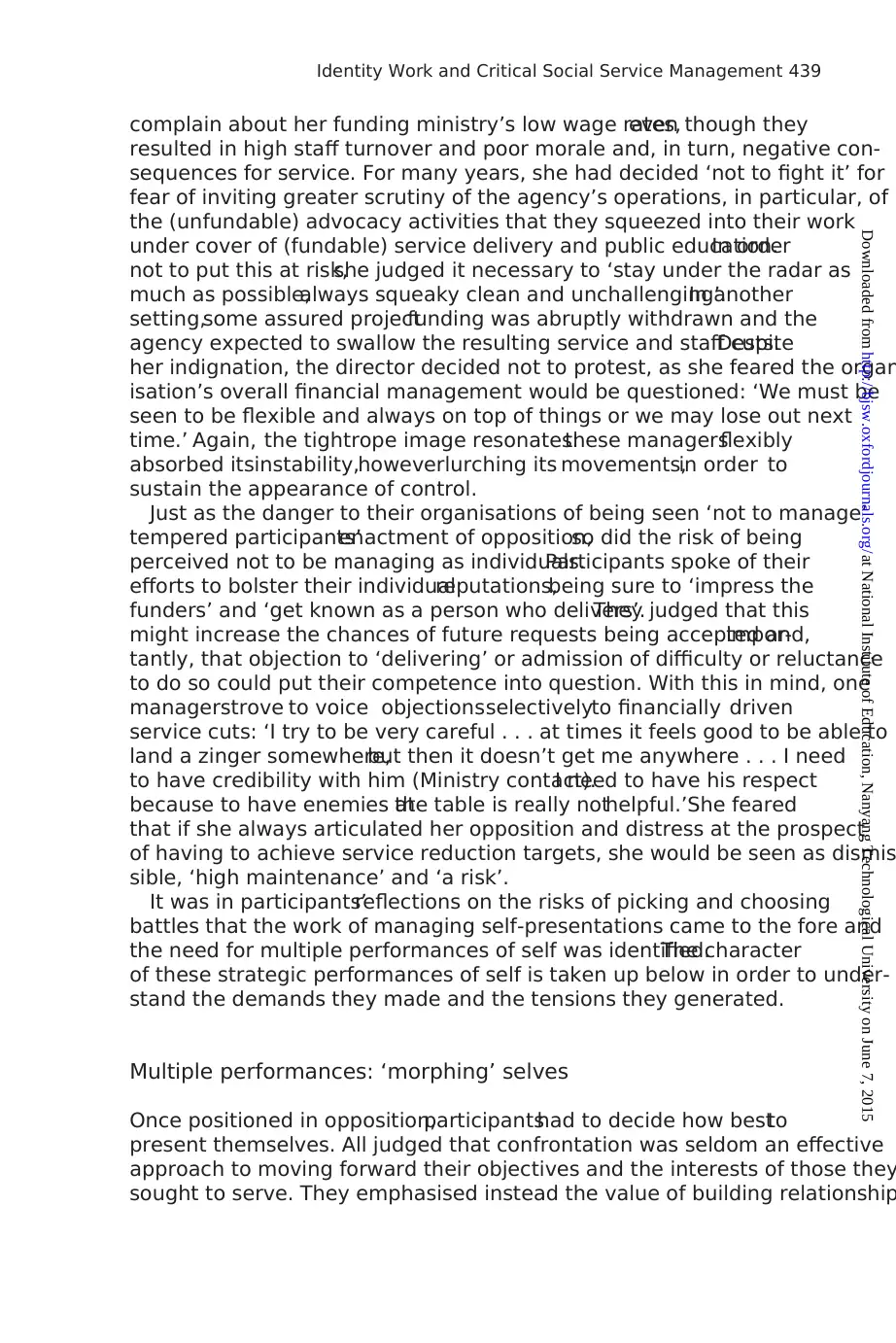
complain about her funding ministry’s low wage rates,even though they
resulted in high staff turnover and poor morale and, in turn, negative con-
sequences for service. For many years, she had decided ‘not to fight it’ for
fear of inviting greater scrutiny of the agency’s operations, in particular, of
the (unfundable) advocacy activities that they squeezed into their work
under cover of (fundable) service delivery and public education.In order
not to put this at risk,she judged it necessary to ‘stay under the radar as
much as possible,always squeaky clean and unchallenging’.In another
setting,some assured projectfunding was abruptly withdrawn and the
agency expected to swallow the resulting service and staff cuts.Despite
her indignation, the director decided not to protest, as she feared the organ
isation’s overall financial management would be questioned: ‘We must be
seen to be flexible and always on top of things or we may lose out next
time.’ Again, the tightrope image resonates:these managersflexibly
absorbed itsinstability,howeverlurching its movements,in order to
sustain the appearance of control.
Just as the danger to their organisations of being seen ‘not to manage’
tempered participants’enactment of opposition,so did the risk of being
perceived not to be managing as individuals.Participants spoke of their
efforts to bolster their individualreputations,being sure to ‘impress the
funders’ and ‘get known as a person who delivers’.They judged that this
might increase the chances of future requests being accepted and,impor-
tantly, that objection to ‘delivering’ or admission of difficulty or reluctance
to do so could put their competence into question. With this in mind, one
managerstrove to voice objectionsselectivelyto financially driven
service cuts: ‘I try to be very careful . . . at times it feels good to be able to
land a zinger somewhere,but then it doesn’t get me anywhere . . . I need
to have credibility with him (Ministry contact).I need to have his respect
because to have enemies atthe table is really nothelpful.’She feared
that if she always articulated her opposition and distress at the prospect
of having to achieve service reduction targets, she would be seen as dismis
sible, ‘high maintenance’ and ‘a risk’.
It was in participants’reflections on the risks of picking and choosing
battles that the work of managing self-presentations came to the fore and
the need for multiple performances of self was identified.The character
of these strategic performances of self is taken up below in order to under-
stand the demands they made and the tensions they generated.
Multiple performances: ‘morphing’ selves
Once positioned in opposition,participantshad to decide how bestto
present themselves. All judged that confrontation was seldom an effective
approach to moving forward their objectives and the interests of those they
sought to serve. They emphasised instead the value of building relationship
Identity Work and Critical Social Service Management 439
at National Institute of Education, Nanyang Technological University on June 7, 2015http://bjsw.oxfordjournals.org/Downloaded from
resulted in high staff turnover and poor morale and, in turn, negative con-
sequences for service. For many years, she had decided ‘not to fight it’ for
fear of inviting greater scrutiny of the agency’s operations, in particular, of
the (unfundable) advocacy activities that they squeezed into their work
under cover of (fundable) service delivery and public education.In order
not to put this at risk,she judged it necessary to ‘stay under the radar as
much as possible,always squeaky clean and unchallenging’.In another
setting,some assured projectfunding was abruptly withdrawn and the
agency expected to swallow the resulting service and staff cuts.Despite
her indignation, the director decided not to protest, as she feared the organ
isation’s overall financial management would be questioned: ‘We must be
seen to be flexible and always on top of things or we may lose out next
time.’ Again, the tightrope image resonates:these managersflexibly
absorbed itsinstability,howeverlurching its movements,in order to
sustain the appearance of control.
Just as the danger to their organisations of being seen ‘not to manage’
tempered participants’enactment of opposition,so did the risk of being
perceived not to be managing as individuals.Participants spoke of their
efforts to bolster their individualreputations,being sure to ‘impress the
funders’ and ‘get known as a person who delivers’.They judged that this
might increase the chances of future requests being accepted and,impor-
tantly, that objection to ‘delivering’ or admission of difficulty or reluctance
to do so could put their competence into question. With this in mind, one
managerstrove to voice objectionsselectivelyto financially driven
service cuts: ‘I try to be very careful . . . at times it feels good to be able to
land a zinger somewhere,but then it doesn’t get me anywhere . . . I need
to have credibility with him (Ministry contact).I need to have his respect
because to have enemies atthe table is really nothelpful.’She feared
that if she always articulated her opposition and distress at the prospect
of having to achieve service reduction targets, she would be seen as dismis
sible, ‘high maintenance’ and ‘a risk’.
It was in participants’reflections on the risks of picking and choosing
battles that the work of managing self-presentations came to the fore and
the need for multiple performances of self was identified.The character
of these strategic performances of self is taken up below in order to under-
stand the demands they made and the tensions they generated.
Multiple performances: ‘morphing’ selves
Once positioned in opposition,participantshad to decide how bestto
present themselves. All judged that confrontation was seldom an effective
approach to moving forward their objectives and the interests of those they
sought to serve. They emphasised instead the value of building relationship
Identity Work and Critical Social Service Management 439
at National Institute of Education, Nanyang Technological University on June 7, 2015http://bjsw.oxfordjournals.org/Downloaded from
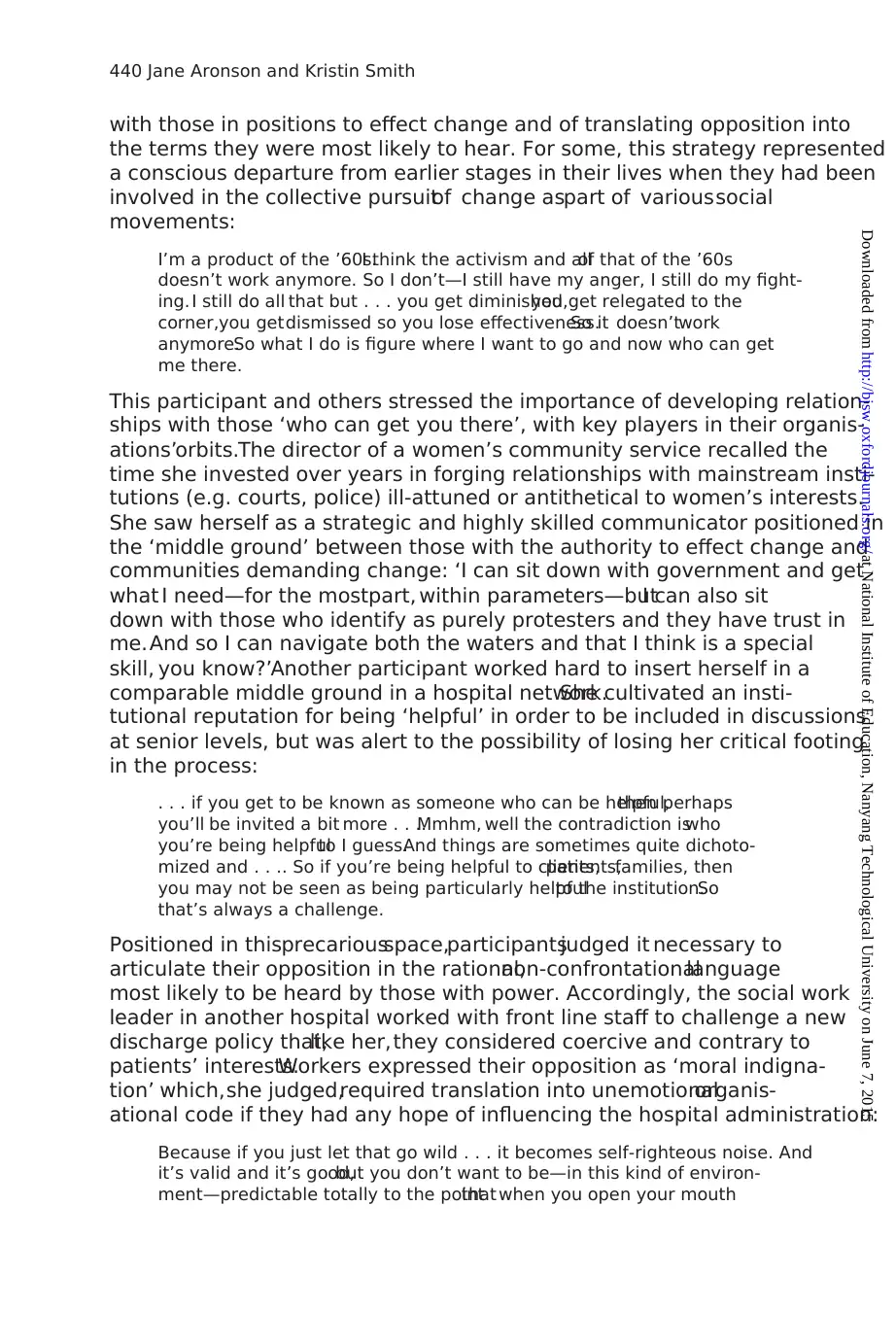
with those in positions to effect change and of translating opposition into
the terms they were most likely to hear. For some, this strategy represented
a conscious departure from earlier stages in their lives when they had been
involved in the collective pursuitof change aspart of varioussocial
movements:
I’m a product of the ’60s.I think the activism and allof that of the ’60s
doesn’t work anymore. So I don’t—I still have my anger, I still do my fight-
ing.I still do all that but . . . you get diminished,you get relegated to the
corner,you getdismissed so you lose effectiveness.So it doesn’twork
anymore.So what I do is figure where I want to go and now who can get
me there.
This participant and others stressed the importance of developing relation-
ships with those ‘who can get you there’, with key players in their organis-
ations’orbits.The director of a women’s community service recalled the
time she invested over years in forging relationships with mainstream insti-
tutions (e.g. courts, police) ill-attuned or antithetical to women’s interests.
She saw herself as a strategic and highly skilled communicator positioned in
the ‘middle ground’ between those with the authority to effect change and
communities demanding change: ‘I can sit down with government and get
what I need—for the mostpart, within parameters—butI can also sit
down with those who identify as purely protesters and they have trust in
me.And so I can navigate both the waters and that I think is a special
skill, you know?’Another participant worked hard to insert herself in a
comparable middle ground in a hospital network.She cultivated an insti-
tutional reputation for being ‘helpful’ in order to be included in discussions
at senior levels, but was alert to the possibility of losing her critical footing
in the process:
. . . if you get to be known as someone who can be helpful,then perhaps
you’ll be invited a bit more . . ..Mmhm, well the contradiction iswho
you’re being helpfulto I guess.And things are sometimes quite dichoto-
mized and . . .. So if you’re being helpful to clients,patients,families, then
you may not be seen as being particularly helpfulto the institution.So
that’s always a challenge.
Positioned in thisprecariousspace,participantsjudged it necessary to
articulate their opposition in the rational,non-confrontationallanguage
most likely to be heard by those with power. Accordingly, the social work
leader in another hospital worked with front line staff to challenge a new
discharge policy that,like her,they considered coercive and contrary to
patients’ interests.Workers expressed their opposition as ‘moral indigna-
tion’ which,she judged,required translation into unemotionalorganis-
ational code if they had any hope of influencing the hospital administration:
Because if you just let that go wild . . . it becomes self-righteous noise. And
it’s valid and it’s good,but you don’t want to be—in this kind of environ-
ment—predictable totally to the pointthat when you open your mouth
440 Jane Aronson and Kristin Smith
at National Institute of Education, Nanyang Technological University on June 7, 2015http://bjsw.oxfordjournals.org/Downloaded from
the terms they were most likely to hear. For some, this strategy represented
a conscious departure from earlier stages in their lives when they had been
involved in the collective pursuitof change aspart of varioussocial
movements:
I’m a product of the ’60s.I think the activism and allof that of the ’60s
doesn’t work anymore. So I don’t—I still have my anger, I still do my fight-
ing.I still do all that but . . . you get diminished,you get relegated to the
corner,you getdismissed so you lose effectiveness.So it doesn’twork
anymore.So what I do is figure where I want to go and now who can get
me there.
This participant and others stressed the importance of developing relation-
ships with those ‘who can get you there’, with key players in their organis-
ations’orbits.The director of a women’s community service recalled the
time she invested over years in forging relationships with mainstream insti-
tutions (e.g. courts, police) ill-attuned or antithetical to women’s interests.
She saw herself as a strategic and highly skilled communicator positioned in
the ‘middle ground’ between those with the authority to effect change and
communities demanding change: ‘I can sit down with government and get
what I need—for the mostpart, within parameters—butI can also sit
down with those who identify as purely protesters and they have trust in
me.And so I can navigate both the waters and that I think is a special
skill, you know?’Another participant worked hard to insert herself in a
comparable middle ground in a hospital network.She cultivated an insti-
tutional reputation for being ‘helpful’ in order to be included in discussions
at senior levels, but was alert to the possibility of losing her critical footing
in the process:
. . . if you get to be known as someone who can be helpful,then perhaps
you’ll be invited a bit more . . ..Mmhm, well the contradiction iswho
you’re being helpfulto I guess.And things are sometimes quite dichoto-
mized and . . .. So if you’re being helpful to clients,patients,families, then
you may not be seen as being particularly helpfulto the institution.So
that’s always a challenge.
Positioned in thisprecariousspace,participantsjudged it necessary to
articulate their opposition in the rational,non-confrontationallanguage
most likely to be heard by those with power. Accordingly, the social work
leader in another hospital worked with front line staff to challenge a new
discharge policy that,like her,they considered coercive and contrary to
patients’ interests.Workers expressed their opposition as ‘moral indigna-
tion’ which,she judged,required translation into unemotionalorganis-
ational code if they had any hope of influencing the hospital administration:
Because if you just let that go wild . . . it becomes self-righteous noise. And
it’s valid and it’s good,but you don’t want to be—in this kind of environ-
ment—predictable totally to the pointthat when you open your mouth
440 Jane Aronson and Kristin Smith
at National Institute of Education, Nanyang Technological University on June 7, 2015http://bjsw.oxfordjournals.org/Downloaded from
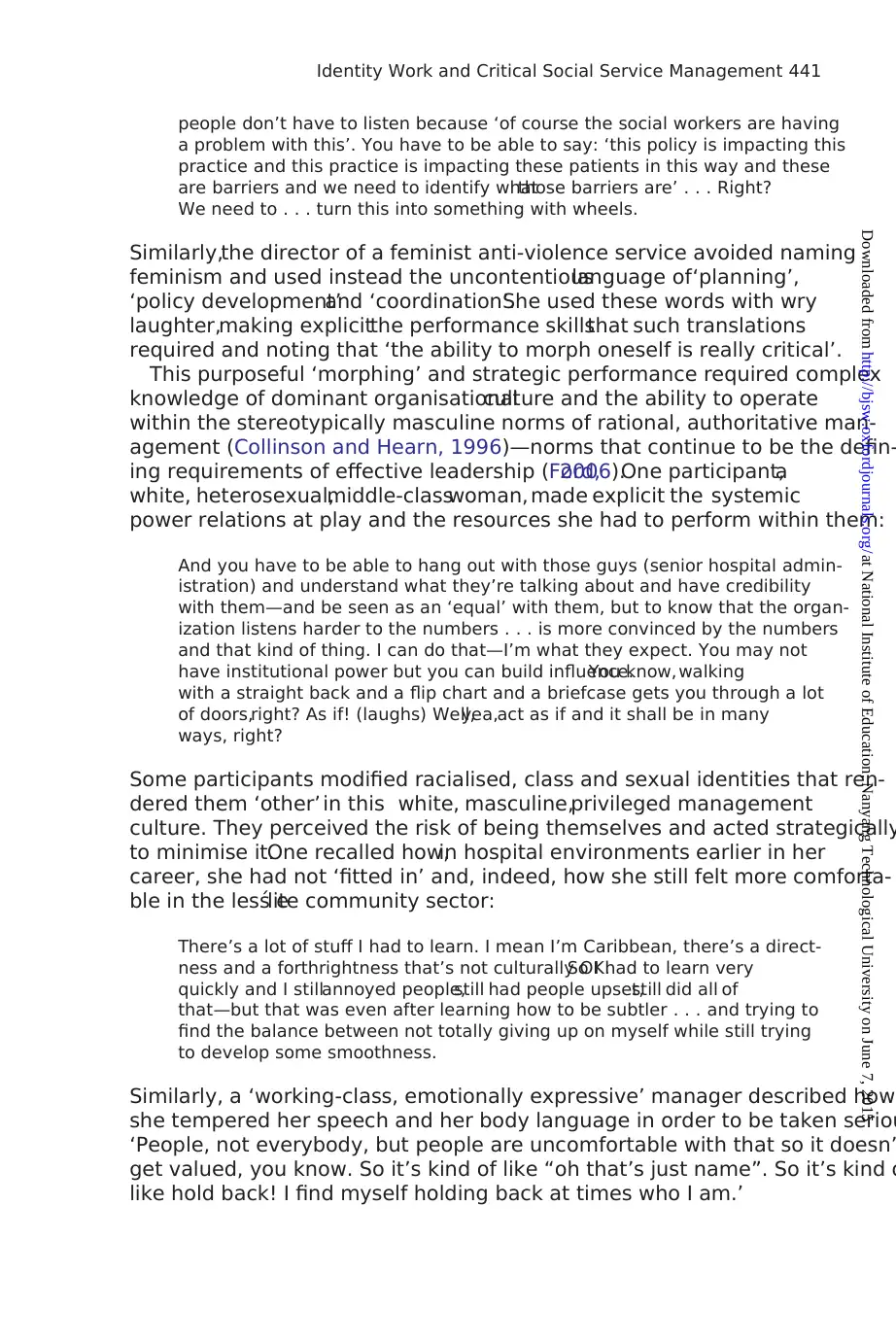
people don’t have to listen because ‘of course the social workers are having
a problem with this’. You have to be able to say: ‘this policy is impacting this
practice and this practice is impacting these patients in this way and these
are barriers and we need to identify whatthose barriers are’ . . . Right?
We need to . . . turn this into something with wheels.
Similarly,the director of a feminist anti-violence service avoided naming
feminism and used instead the uncontentiouslanguage of‘planning’,
‘policy development’and ‘coordination’.She used these words with wry
laughter,making explicitthe performance skillsthat such translations
required and noting that ‘the ability to morph oneself is really critical’.
This purposeful ‘morphing’ and strategic performance required complex
knowledge of dominant organisationalculture and the ability to operate
within the stereotypically masculine norms of rational, authoritative man-
agement (Collinson and Hearn, 1996)—norms that continue to be the defin-
ing requirements of effective leadership (Ford,2006).One participant,a
white, heterosexual,middle-classwoman, made explicit the systemic
power relations at play and the resources she had to perform within them:
And you have to be able to hang out with those guys (senior hospital admin-
istration) and understand what they’re talking about and have credibility
with them—and be seen as an ‘equal’ with them, but to know that the organ-
ization listens harder to the numbers . . . is more convinced by the numbers
and that kind of thing. I can do that—I’m what they expect. You may not
have institutional power but you can build influence.You know,walking
with a straight back and a flip chart and a briefcase gets you through a lot
of doors,right? As if! (laughs) Well,yea,act as if and it shall be in many
ways, right?
Some participants modified racialised, class and sexual identities that ren-
dered them ‘other’ in this white, masculine,privileged management
culture. They perceived the risk of being themselves and acted strategically
to minimise it.One recalled how,in hospital environments earlier in her
career, she had not ‘fitted in’ and, indeed, how she still felt more comforta-
ble in the less e´lite community sector:
There’s a lot of stuff I had to learn. I mean I’m Caribbean, there’s a direct-
ness and a forthrightness that’s not culturally OK.So I had to learn very
quickly and I stillannoyed people,still had people upset,still did all of
that—but that was even after learning how to be subtler . . . and trying to
find the balance between not totally giving up on myself while still trying
to develop some smoothness.
Similarly, a ‘working-class, emotionally expressive’ manager described how
she tempered her speech and her body language in order to be taken seriou
‘People, not everybody, but people are uncomfortable with that so it doesn’
get valued, you know. So it’s kind of like “oh that’s just name”. So it’s kind o
like hold back! I find myself holding back at times who I am.’
Identity Work and Critical Social Service Management 441
at National Institute of Education, Nanyang Technological University on June 7, 2015http://bjsw.oxfordjournals.org/Downloaded from
a problem with this’. You have to be able to say: ‘this policy is impacting this
practice and this practice is impacting these patients in this way and these
are barriers and we need to identify whatthose barriers are’ . . . Right?
We need to . . . turn this into something with wheels.
Similarly,the director of a feminist anti-violence service avoided naming
feminism and used instead the uncontentiouslanguage of‘planning’,
‘policy development’and ‘coordination’.She used these words with wry
laughter,making explicitthe performance skillsthat such translations
required and noting that ‘the ability to morph oneself is really critical’.
This purposeful ‘morphing’ and strategic performance required complex
knowledge of dominant organisationalculture and the ability to operate
within the stereotypically masculine norms of rational, authoritative man-
agement (Collinson and Hearn, 1996)—norms that continue to be the defin-
ing requirements of effective leadership (Ford,2006).One participant,a
white, heterosexual,middle-classwoman, made explicit the systemic
power relations at play and the resources she had to perform within them:
And you have to be able to hang out with those guys (senior hospital admin-
istration) and understand what they’re talking about and have credibility
with them—and be seen as an ‘equal’ with them, but to know that the organ-
ization listens harder to the numbers . . . is more convinced by the numbers
and that kind of thing. I can do that—I’m what they expect. You may not
have institutional power but you can build influence.You know,walking
with a straight back and a flip chart and a briefcase gets you through a lot
of doors,right? As if! (laughs) Well,yea,act as if and it shall be in many
ways, right?
Some participants modified racialised, class and sexual identities that ren-
dered them ‘other’ in this white, masculine,privileged management
culture. They perceived the risk of being themselves and acted strategically
to minimise it.One recalled how,in hospital environments earlier in her
career, she had not ‘fitted in’ and, indeed, how she still felt more comforta-
ble in the less e´lite community sector:
There’s a lot of stuff I had to learn. I mean I’m Caribbean, there’s a direct-
ness and a forthrightness that’s not culturally OK.So I had to learn very
quickly and I stillannoyed people,still had people upset,still did all of
that—but that was even after learning how to be subtler . . . and trying to
find the balance between not totally giving up on myself while still trying
to develop some smoothness.
Similarly, a ‘working-class, emotionally expressive’ manager described how
she tempered her speech and her body language in order to be taken seriou
‘People, not everybody, but people are uncomfortable with that so it doesn’
get valued, you know. So it’s kind of like “oh that’s just name”. So it’s kind o
like hold back! I find myself holding back at times who I am.’
Identity Work and Critical Social Service Management 441
at National Institute of Education, Nanyang Technological University on June 7, 2015http://bjsw.oxfordjournals.org/Downloaded from
Secure Best Marks with AI Grader
Need help grading? Try our AI Grader for instant feedback on your assignments.
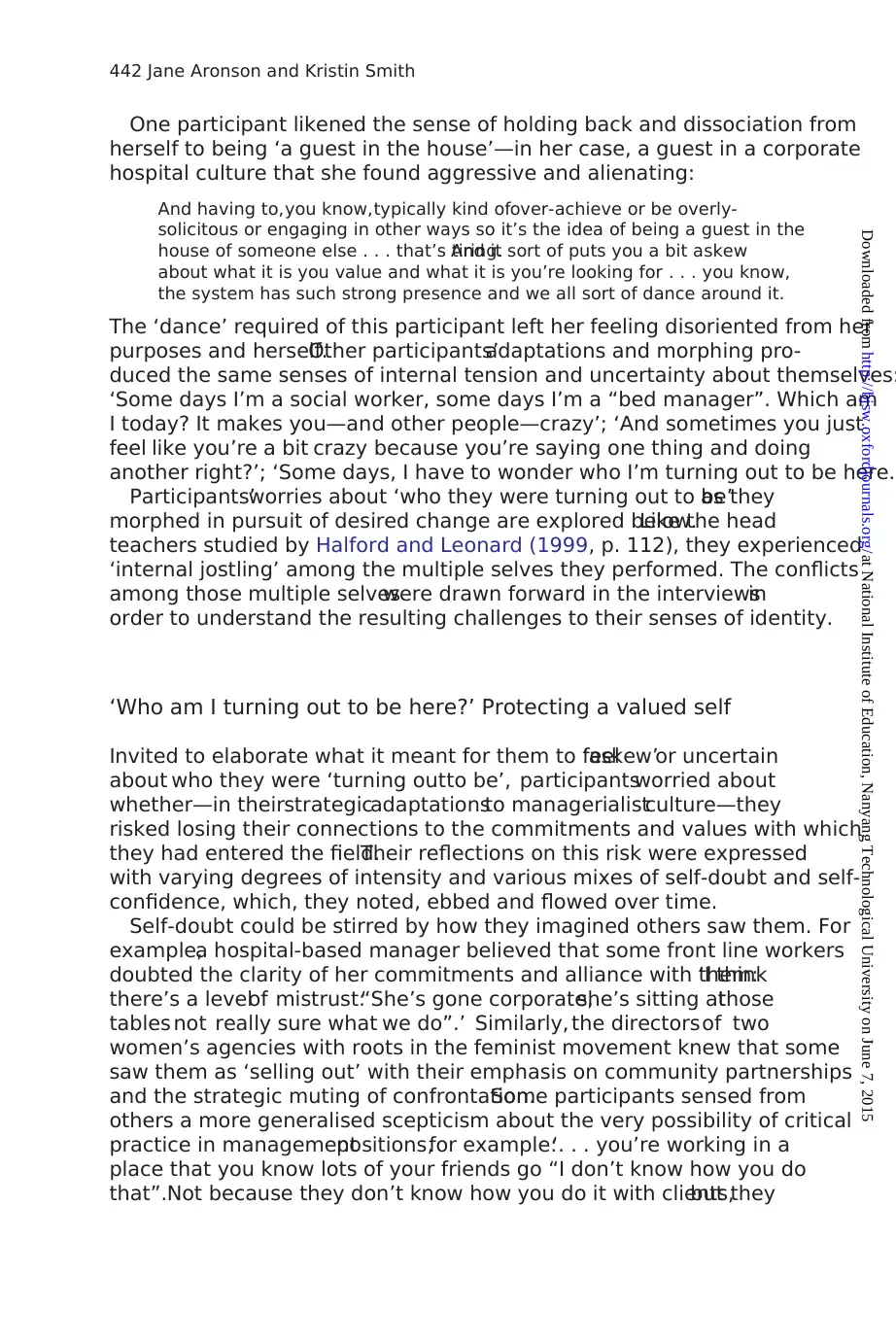
One participant likened the sense of holding back and dissociation from
herself to being ‘a guest in the house’—in her case, a guest in a corporate
hospital culture that she found aggressive and alienating:
And having to,you know,typically kind ofover-achieve or be overly-
solicitous or engaging in other ways so it’s the idea of being a guest in the
house of someone else . . . that’s tiring.And it sort of puts you a bit askew
about what it is you value and what it is you’re looking for . . . you know,
the system has such strong presence and we all sort of dance around it.
The ‘dance’ required of this participant left her feeling disoriented from her
purposes and herself.Other participants’adaptations and morphing pro-
duced the same senses of internal tension and uncertainty about themselves:
‘Some days I’m a social worker, some days I’m a “bed manager”. Which am
I today? It makes you—and other people—crazy’; ‘And sometimes you just
feel like you’re a bit crazy because you’re saying one thing and doing
another right?’; ‘Some days, I have to wonder who I’m turning out to be here.
Participants’worries about ‘who they were turning out to be’as they
morphed in pursuit of desired change are explored below.Like the head
teachers studied by Halford and Leonard (1999, p. 112), they experienced
‘internal jostling’ among the multiple selves they performed. The conflicts
among those multiple selveswere drawn forward in the interviewsin
order to understand the resulting challenges to their senses of identity.
‘Who am I turning out to be here?’ Protecting a valued self
Invited to elaborate what it meant for them to feel‘askew’or uncertain
about who they were ‘turning outto be’, participantsworried about
whether—in theirstrategicadaptationsto managerialistculture—they
risked losing their connections to the commitments and values with which
they had entered the field.Their reflections on this risk were expressed
with varying degrees of intensity and various mixes of self-doubt and self-
confidence, which, they noted, ebbed and flowed over time.
Self-doubt could be stirred by how they imagined others saw them. For
example,a hospital-based manager believed that some front line workers
doubted the clarity of her commitments and alliance with them:‘I think
there’s a levelof mistrust:“She’s gone corporate,she’s sitting atthose
tables not really sure what we do”.’ Similarly, the directorsof two
women’s agencies with roots in the feminist movement knew that some
saw them as ‘selling out’ with their emphasis on community partnerships
and the strategic muting of confrontation.Some participants sensed from
others a more generalised scepticism about the very possibility of critical
practice in managementpositions,for example:‘. . . you’re working in a
place that you know lots of your friends go “I don’t know how you do
that”.Not because they don’t know how you do it with clients,but they
442 Jane Aronson and Kristin Smith
at National Institute of Education, Nanyang Technological University on June 7, 2015http://bjsw.oxfordjournals.org/Downloaded from
herself to being ‘a guest in the house’—in her case, a guest in a corporate
hospital culture that she found aggressive and alienating:
And having to,you know,typically kind ofover-achieve or be overly-
solicitous or engaging in other ways so it’s the idea of being a guest in the
house of someone else . . . that’s tiring.And it sort of puts you a bit askew
about what it is you value and what it is you’re looking for . . . you know,
the system has such strong presence and we all sort of dance around it.
The ‘dance’ required of this participant left her feeling disoriented from her
purposes and herself.Other participants’adaptations and morphing pro-
duced the same senses of internal tension and uncertainty about themselves:
‘Some days I’m a social worker, some days I’m a “bed manager”. Which am
I today? It makes you—and other people—crazy’; ‘And sometimes you just
feel like you’re a bit crazy because you’re saying one thing and doing
another right?’; ‘Some days, I have to wonder who I’m turning out to be here.
Participants’worries about ‘who they were turning out to be’as they
morphed in pursuit of desired change are explored below.Like the head
teachers studied by Halford and Leonard (1999, p. 112), they experienced
‘internal jostling’ among the multiple selves they performed. The conflicts
among those multiple selveswere drawn forward in the interviewsin
order to understand the resulting challenges to their senses of identity.
‘Who am I turning out to be here?’ Protecting a valued self
Invited to elaborate what it meant for them to feel‘askew’or uncertain
about who they were ‘turning outto be’, participantsworried about
whether—in theirstrategicadaptationsto managerialistculture—they
risked losing their connections to the commitments and values with which
they had entered the field.Their reflections on this risk were expressed
with varying degrees of intensity and various mixes of self-doubt and self-
confidence, which, they noted, ebbed and flowed over time.
Self-doubt could be stirred by how they imagined others saw them. For
example,a hospital-based manager believed that some front line workers
doubted the clarity of her commitments and alliance with them:‘I think
there’s a levelof mistrust:“She’s gone corporate,she’s sitting atthose
tables not really sure what we do”.’ Similarly, the directorsof two
women’s agencies with roots in the feminist movement knew that some
saw them as ‘selling out’ with their emphasis on community partnerships
and the strategic muting of confrontation.Some participants sensed from
others a more generalised scepticism about the very possibility of critical
practice in managementpositions,for example:‘. . . you’re working in a
place that you know lots of your friends go “I don’t know how you do
that”.Not because they don’t know how you do it with clients,but they
442 Jane Aronson and Kristin Smith
at National Institute of Education, Nanyang Technological University on June 7, 2015http://bjsw.oxfordjournals.org/Downloaded from
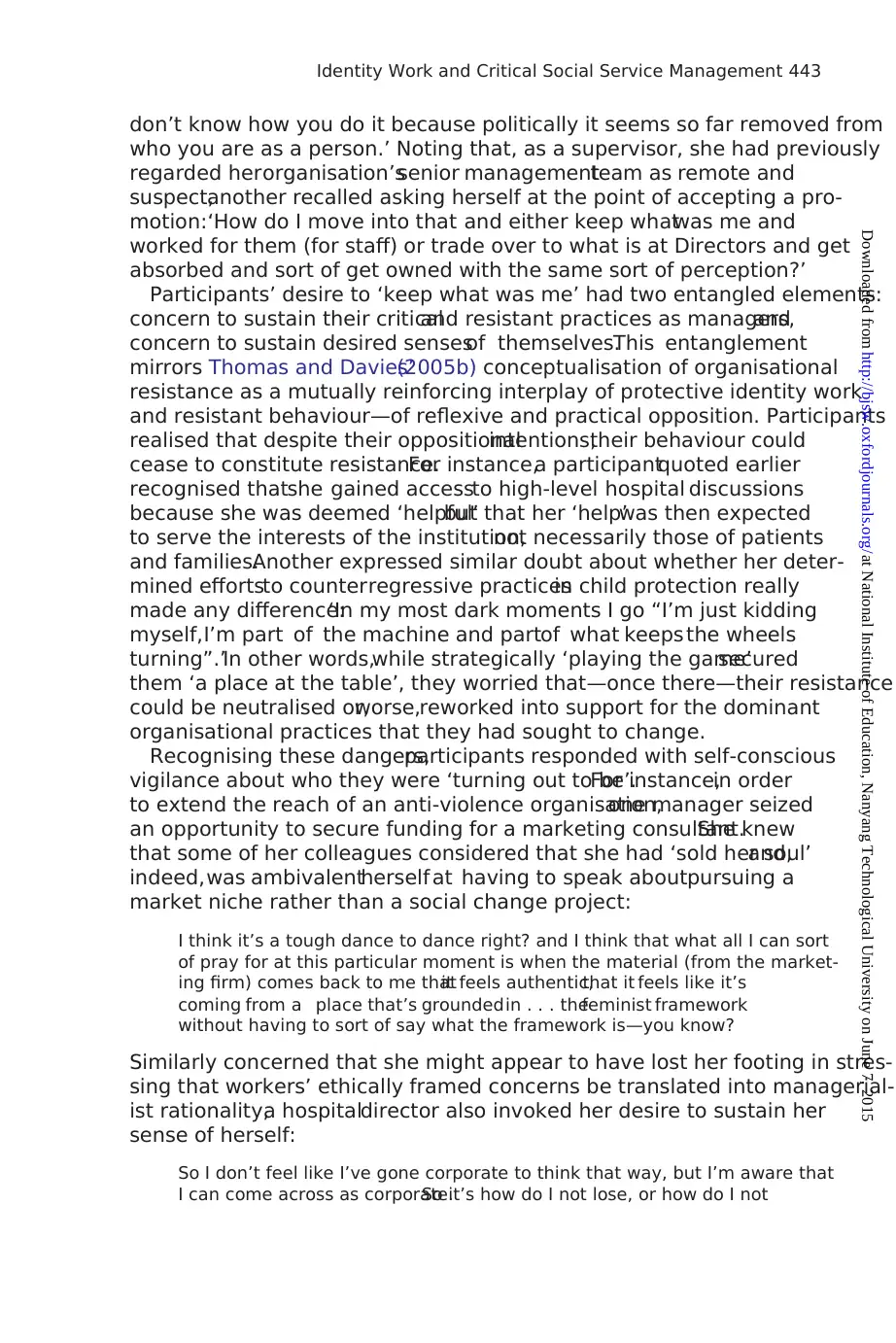
don’t know how you do it because politically it seems so far removed from
who you are as a person.’ Noting that, as a supervisor, she had previously
regarded herorganisation’ssenior managementteam as remote and
suspect,another recalled asking herself at the point of accepting a pro-
motion:‘How do I move into that and either keep whatwas me and
worked for them (for staff) or trade over to what is at Directors and get
absorbed and sort of get owned with the same sort of perception?’
Participants’ desire to ‘keep what was me’ had two entangled elements:
concern to sustain their criticaland resistant practices as managers,and
concern to sustain desired sensesof themselves.This entanglement
mirrors Thomas and Davies’(2005b) conceptualisation of organisational
resistance as a mutually reinforcing interplay of protective identity work
and resistant behaviour—of reflexive and practical opposition. Participants
realised that despite their oppositionalintentions,their behaviour could
cease to constitute resistance.For instance,a participantquoted earlier
recognised thatshe gained accessto high-level hospital discussions
because she was deemed ‘helpful’but that her ‘help’was then expected
to serve the interests of the institution,not necessarily those of patients
and families.Another expressed similar doubt about whether her deter-
mined effortsto counterregressive practicesin child protection really
made any difference:‘In my most dark moments I go “I’m just kidding
myself,I’m part of the machine and partof what keeps the wheels
turning”.’In other words,while strategically ‘playing the game’secured
them ‘a place at the table’, they worried that—once there—their resistance
could be neutralised or,worse,reworked into support for the dominant
organisational practices that they had sought to change.
Recognising these dangers,participants responded with self-conscious
vigilance about who they were ‘turning out to be’.For instance,in order
to extend the reach of an anti-violence organisation,one manager seized
an opportunity to secure funding for a marketing consultant.She knew
that some of her colleagues considered that she had ‘sold her soul’and,
indeed,was ambivalentherself at having to speak aboutpursuing a
market niche rather than a social change project:
I think it’s a tough dance to dance right? and I think that what all I can sort
of pray for at this particular moment is when the material (from the market-
ing firm) comes back to me thatit feels authentic,that it feels like it’s
coming from a place that’s groundedin . . . thefeminist framework
without having to sort of say what the framework is—you know?
Similarly concerned that she might appear to have lost her footing in stres-
sing that workers’ ethically framed concerns be translated into managerial-
ist rationality,a hospitaldirector also invoked her desire to sustain her
sense of herself:
So I don’t feel like I’ve gone corporate to think that way, but I’m aware that
I can come across as corporate.So it’s how do I not lose, or how do I not
Identity Work and Critical Social Service Management 443
at National Institute of Education, Nanyang Technological University on June 7, 2015http://bjsw.oxfordjournals.org/Downloaded from
who you are as a person.’ Noting that, as a supervisor, she had previously
regarded herorganisation’ssenior managementteam as remote and
suspect,another recalled asking herself at the point of accepting a pro-
motion:‘How do I move into that and either keep whatwas me and
worked for them (for staff) or trade over to what is at Directors and get
absorbed and sort of get owned with the same sort of perception?’
Participants’ desire to ‘keep what was me’ had two entangled elements:
concern to sustain their criticaland resistant practices as managers,and
concern to sustain desired sensesof themselves.This entanglement
mirrors Thomas and Davies’(2005b) conceptualisation of organisational
resistance as a mutually reinforcing interplay of protective identity work
and resistant behaviour—of reflexive and practical opposition. Participants
realised that despite their oppositionalintentions,their behaviour could
cease to constitute resistance.For instance,a participantquoted earlier
recognised thatshe gained accessto high-level hospital discussions
because she was deemed ‘helpful’but that her ‘help’was then expected
to serve the interests of the institution,not necessarily those of patients
and families.Another expressed similar doubt about whether her deter-
mined effortsto counterregressive practicesin child protection really
made any difference:‘In my most dark moments I go “I’m just kidding
myself,I’m part of the machine and partof what keeps the wheels
turning”.’In other words,while strategically ‘playing the game’secured
them ‘a place at the table’, they worried that—once there—their resistance
could be neutralised or,worse,reworked into support for the dominant
organisational practices that they had sought to change.
Recognising these dangers,participants responded with self-conscious
vigilance about who they were ‘turning out to be’.For instance,in order
to extend the reach of an anti-violence organisation,one manager seized
an opportunity to secure funding for a marketing consultant.She knew
that some of her colleagues considered that she had ‘sold her soul’and,
indeed,was ambivalentherself at having to speak aboutpursuing a
market niche rather than a social change project:
I think it’s a tough dance to dance right? and I think that what all I can sort
of pray for at this particular moment is when the material (from the market-
ing firm) comes back to me thatit feels authentic,that it feels like it’s
coming from a place that’s groundedin . . . thefeminist framework
without having to sort of say what the framework is—you know?
Similarly concerned that she might appear to have lost her footing in stres-
sing that workers’ ethically framed concerns be translated into managerial-
ist rationality,a hospitaldirector also invoked her desire to sustain her
sense of herself:
So I don’t feel like I’ve gone corporate to think that way, but I’m aware that
I can come across as corporate.So it’s how do I not lose, or how do I not
Identity Work and Critical Social Service Management 443
at National Institute of Education, Nanyang Technological University on June 7, 2015http://bjsw.oxfordjournals.org/Downloaded from
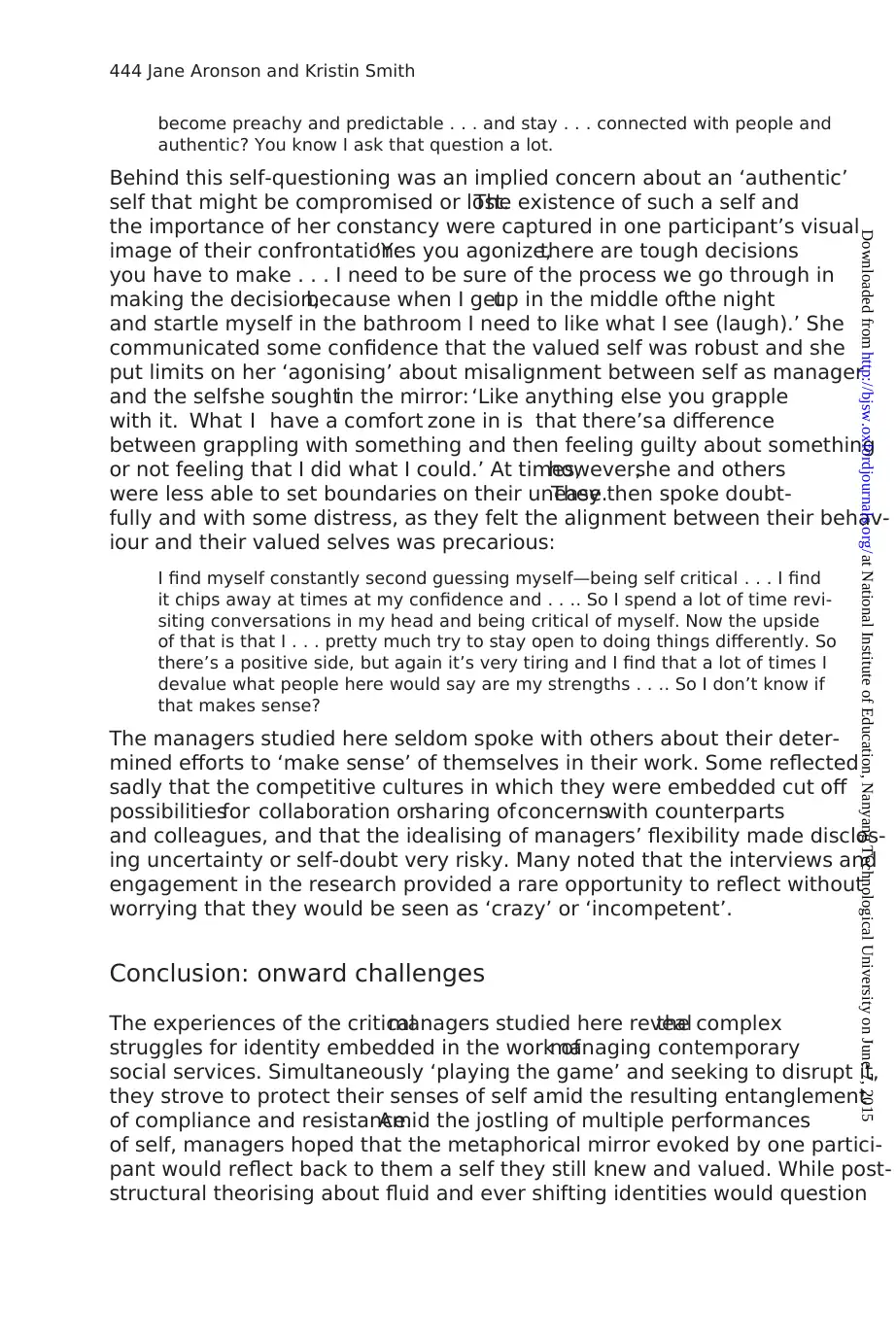
become preachy and predictable . . . and stay . . . connected with people and
authentic? You know I ask that question a lot.
Behind this self-questioning was an implied concern about an ‘authentic’
self that might be compromised or lost.The existence of such a self and
the importance of her constancy were captured in one participant’s visual
image of their confrontation:‘Yes you agonize,there are tough decisions
you have to make . . . I need to be sure of the process we go through in
making the decision,because when I getup in the middle ofthe night
and startle myself in the bathroom I need to like what I see (laugh).’ She
communicated some confidence that the valued self was robust and she
put limits on her ‘agonising’ about misalignment between self as manager
and the selfshe soughtin the mirror: ‘Like anything else you grapple
with it. What I have a comfort zone in is that there’sa difference
between grappling with something and then feeling guilty about something
or not feeling that I did what I could.’ At times,however,she and others
were less able to set boundaries on their unease.They then spoke doubt-
fully and with some distress, as they felt the alignment between their behav-
iour and their valued selves was precarious:
I find myself constantly second guessing myself—being self critical . . . I find
it chips away at times at my confidence and . . .. So I spend a lot of time revi-
siting conversations in my head and being critical of myself. Now the upside
of that is that I . . . pretty much try to stay open to doing things differently. So
there’s a positive side, but again it’s very tiring and I find that a lot of times I
devalue what people here would say are my strengths . . .. So I don’t know if
that makes sense?
The managers studied here seldom spoke with others about their deter-
mined efforts to ‘make sense’ of themselves in their work. Some reflected
sadly that the competitive cultures in which they were embedded cut off
possibilitiesfor collaboration orsharing ofconcernswith counterparts
and colleagues, and that the idealising of managers’ flexibility made disclos-
ing uncertainty or self-doubt very risky. Many noted that the interviews and
engagement in the research provided a rare opportunity to reflect without
worrying that they would be seen as ‘crazy’ or ‘incompetent’.
Conclusion: onward challenges
The experiences of the criticalmanagers studied here revealthe complex
struggles for identity embedded in the work ofmanaging contemporary
social services. Simultaneously ‘playing the game’ and seeking to disrupt it,
they strove to protect their senses of self amid the resulting entanglement
of compliance and resistance.Amid the jostling of multiple performances
of self, managers hoped that the metaphorical mirror evoked by one partici-
pant would reflect back to them a self they still knew and valued. While post-
structural theorising about fluid and ever shifting identities would question
444 Jane Aronson and Kristin Smith
at National Institute of Education, Nanyang Technological University on June 7, 2015http://bjsw.oxfordjournals.org/Downloaded from
authentic? You know I ask that question a lot.
Behind this self-questioning was an implied concern about an ‘authentic’
self that might be compromised or lost.The existence of such a self and
the importance of her constancy were captured in one participant’s visual
image of their confrontation:‘Yes you agonize,there are tough decisions
you have to make . . . I need to be sure of the process we go through in
making the decision,because when I getup in the middle ofthe night
and startle myself in the bathroom I need to like what I see (laugh).’ She
communicated some confidence that the valued self was robust and she
put limits on her ‘agonising’ about misalignment between self as manager
and the selfshe soughtin the mirror: ‘Like anything else you grapple
with it. What I have a comfort zone in is that there’sa difference
between grappling with something and then feeling guilty about something
or not feeling that I did what I could.’ At times,however,she and others
were less able to set boundaries on their unease.They then spoke doubt-
fully and with some distress, as they felt the alignment between their behav-
iour and their valued selves was precarious:
I find myself constantly second guessing myself—being self critical . . . I find
it chips away at times at my confidence and . . .. So I spend a lot of time revi-
siting conversations in my head and being critical of myself. Now the upside
of that is that I . . . pretty much try to stay open to doing things differently. So
there’s a positive side, but again it’s very tiring and I find that a lot of times I
devalue what people here would say are my strengths . . .. So I don’t know if
that makes sense?
The managers studied here seldom spoke with others about their deter-
mined efforts to ‘make sense’ of themselves in their work. Some reflected
sadly that the competitive cultures in which they were embedded cut off
possibilitiesfor collaboration orsharing ofconcernswith counterparts
and colleagues, and that the idealising of managers’ flexibility made disclos-
ing uncertainty or self-doubt very risky. Many noted that the interviews and
engagement in the research provided a rare opportunity to reflect without
worrying that they would be seen as ‘crazy’ or ‘incompetent’.
Conclusion: onward challenges
The experiences of the criticalmanagers studied here revealthe complex
struggles for identity embedded in the work ofmanaging contemporary
social services. Simultaneously ‘playing the game’ and seeking to disrupt it,
they strove to protect their senses of self amid the resulting entanglement
of compliance and resistance.Amid the jostling of multiple performances
of self, managers hoped that the metaphorical mirror evoked by one partici-
pant would reflect back to them a self they still knew and valued. While post-
structural theorising about fluid and ever shifting identities would question
444 Jane Aronson and Kristin Smith
at National Institute of Education, Nanyang Technological University on June 7, 2015http://bjsw.oxfordjournals.org/Downloaded from
Paraphrase This Document
Need a fresh take? Get an instant paraphrase of this document with our AI Paraphraser
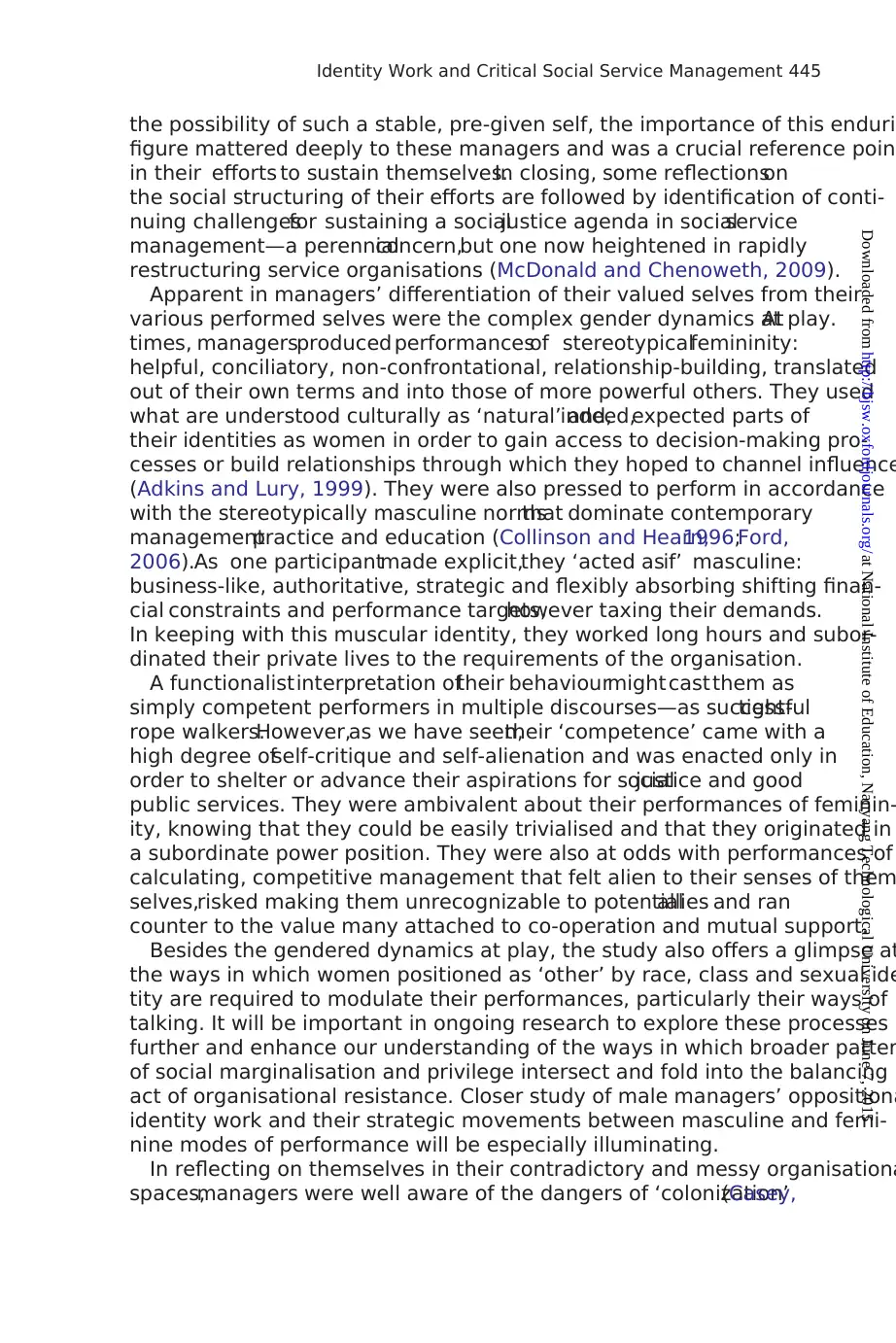
the possibility of such a stable, pre-given self, the importance of this enduri
figure mattered deeply to these managers and was a crucial reference poin
in their efforts to sustain themselves.In closing, some reflectionson
the social structuring of their efforts are followed by identification of conti-
nuing challengesfor sustaining a socialjustice agenda in socialservice
management—a perennialconcern,but one now heightened in rapidly
restructuring service organisations (McDonald and Chenoweth, 2009).
Apparent in managers’ differentiation of their valued selves from their
various performed selves were the complex gender dynamics at play.At
times, managersproduced performancesof stereotypicalfemininity:
helpful, conciliatory, non-confrontational, relationship-building, translated
out of their own terms and into those of more powerful others. They used
what are understood culturally as ‘natural’ and,indeed,expected parts of
their identities as women in order to gain access to decision-making pro-
cesses or build relationships through which they hoped to channel influence
(Adkins and Lury, 1999). They were also pressed to perform in accordance
with the stereotypically masculine normsthat dominate contemporary
managementpractice and education (Collinson and Hearn,1996;Ford,
2006).As one participantmade explicit,they ‘acted asif’ masculine:
business-like, authoritative, strategic and flexibly absorbing shifting finan-
cial constraints and performance targets,however taxing their demands.
In keeping with this muscular identity, they worked long hours and subor-
dinated their private lives to the requirements of the organisation.
A functionalistinterpretation oftheir behaviourmightcastthem as
simply competent performers in multiple discourses—as successfultight-
rope walkers.However,as we have seen,their ‘competence’ came with a
high degree ofself-critique and self-alienation and was enacted only in
order to shelter or advance their aspirations for socialjustice and good
public services. They were ambivalent about their performances of feminin-
ity, knowing that they could be easily trivialised and that they originated in
a subordinate power position. They were also at odds with performances of
calculating, competitive management that felt alien to their senses of them
selves,risked making them unrecognizable to potentialallies and ran
counter to the value many attached to co-operation and mutual support.
Besides the gendered dynamics at play, the study also offers a glimpse at
the ways in which women positioned as ‘other’ by race, class and sexual ide
tity are required to modulate their performances, particularly their ways of
talking. It will be important in ongoing research to explore these processes
further and enhance our understanding of the ways in which broader patter
of social marginalisation and privilege intersect and fold into the balancing
act of organisational resistance. Closer study of male managers’ oppositiona
identity work and their strategic movements between masculine and femi-
nine modes of performance will be especially illuminating.
In reflecting on themselves in their contradictory and messy organisationa
spaces,managers were well aware of the dangers of ‘colonization’(Casey,
Identity Work and Critical Social Service Management 445
at National Institute of Education, Nanyang Technological University on June 7, 2015http://bjsw.oxfordjournals.org/Downloaded from
figure mattered deeply to these managers and was a crucial reference poin
in their efforts to sustain themselves.In closing, some reflectionson
the social structuring of their efforts are followed by identification of conti-
nuing challengesfor sustaining a socialjustice agenda in socialservice
management—a perennialconcern,but one now heightened in rapidly
restructuring service organisations (McDonald and Chenoweth, 2009).
Apparent in managers’ differentiation of their valued selves from their
various performed selves were the complex gender dynamics at play.At
times, managersproduced performancesof stereotypicalfemininity:
helpful, conciliatory, non-confrontational, relationship-building, translated
out of their own terms and into those of more powerful others. They used
what are understood culturally as ‘natural’ and,indeed,expected parts of
their identities as women in order to gain access to decision-making pro-
cesses or build relationships through which they hoped to channel influence
(Adkins and Lury, 1999). They were also pressed to perform in accordance
with the stereotypically masculine normsthat dominate contemporary
managementpractice and education (Collinson and Hearn,1996;Ford,
2006).As one participantmade explicit,they ‘acted asif’ masculine:
business-like, authoritative, strategic and flexibly absorbing shifting finan-
cial constraints and performance targets,however taxing their demands.
In keeping with this muscular identity, they worked long hours and subor-
dinated their private lives to the requirements of the organisation.
A functionalistinterpretation oftheir behaviourmightcastthem as
simply competent performers in multiple discourses—as successfultight-
rope walkers.However,as we have seen,their ‘competence’ came with a
high degree ofself-critique and self-alienation and was enacted only in
order to shelter or advance their aspirations for socialjustice and good
public services. They were ambivalent about their performances of feminin-
ity, knowing that they could be easily trivialised and that they originated in
a subordinate power position. They were also at odds with performances of
calculating, competitive management that felt alien to their senses of them
selves,risked making them unrecognizable to potentialallies and ran
counter to the value many attached to co-operation and mutual support.
Besides the gendered dynamics at play, the study also offers a glimpse at
the ways in which women positioned as ‘other’ by race, class and sexual ide
tity are required to modulate their performances, particularly their ways of
talking. It will be important in ongoing research to explore these processes
further and enhance our understanding of the ways in which broader patter
of social marginalisation and privilege intersect and fold into the balancing
act of organisational resistance. Closer study of male managers’ oppositiona
identity work and their strategic movements between masculine and femi-
nine modes of performance will be especially illuminating.
In reflecting on themselves in their contradictory and messy organisationa
spaces,managers were well aware of the dangers of ‘colonization’(Casey,
Identity Work and Critical Social Service Management 445
at National Institute of Education, Nanyang Technological University on June 7, 2015http://bjsw.oxfordjournals.org/Downloaded from
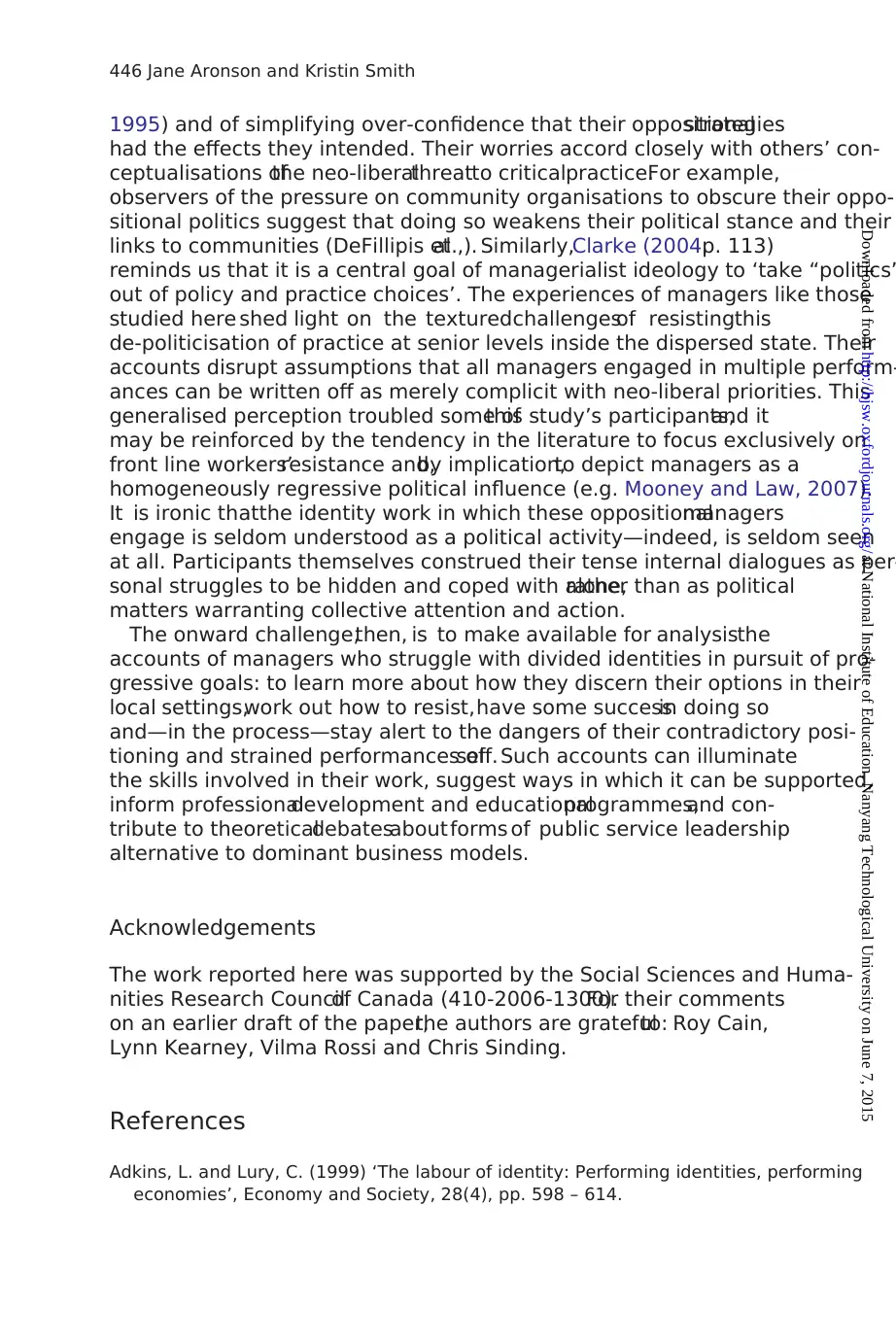
1995) and of simplifying over-confidence that their oppositionalstrategies
had the effects they intended. Their worries accord closely with others’ con-
ceptualisations ofthe neo-liberalthreatto criticalpractice.For example,
observers of the pressure on community organisations to obscure their oppo-
sitional politics suggest that doing so weakens their political stance and their
links to communities (DeFillipis etal.,). Similarly,Clarke (2004,p. 113)
reminds us that it is a central goal of managerialist ideology to ‘take “politics”
out of policy and practice choices’. The experiences of managers like those
studied here shed light on the texturedchallengesof resistingthis
de-politicisation of practice at senior levels inside the dispersed state. Their
accounts disrupt assumptions that all managers engaged in multiple perform-
ances can be written off as merely complicit with neo-liberal priorities. This
generalised perception troubled some ofthis study’s participants,and it
may be reinforced by the tendency in the literature to focus exclusively on
front line workers’resistance and,by implication,to depict managers as a
homogeneously regressive political influence (e.g. Mooney and Law, 2007).
It is ironic thatthe identity work in which these oppositionalmanagers
engage is seldom understood as a political activity—indeed, is seldom seen
at all. Participants themselves construed their tense internal dialogues as per-
sonal struggles to be hidden and coped with alone,rather than as political
matters warranting collective attention and action.
The onward challenge,then, is to make available for analysisthe
accounts of managers who struggle with divided identities in pursuit of pro-
gressive goals: to learn more about how they discern their options in their
local settings,work out how to resist,have some successin doing so
and—in the process—stay alert to the dangers of their contradictory posi-
tioning and strained performances ofself. Such accounts can illuminate
the skills involved in their work, suggest ways in which it can be supported,
inform professionaldevelopment and educationalprogrammes,and con-
tribute to theoreticaldebatesaboutforms of public service leadership
alternative to dominant business models.
Acknowledgements
The work reported here was supported by the Social Sciences and Huma-
nities Research Councilof Canada (410-2006-1300).For their comments
on an earlier draft of the paper,the authors are gratefulto: Roy Cain,
Lynn Kearney, Vilma Rossi and Chris Sinding.
References
Adkins, L. and Lury, C. (1999) ‘The labour of identity: Performing identities, performing
economies’, Economy and Society, 28(4), pp. 598 – 614.
446 Jane Aronson and Kristin Smith
at National Institute of Education, Nanyang Technological University on June 7, 2015http://bjsw.oxfordjournals.org/Downloaded from
had the effects they intended. Their worries accord closely with others’ con-
ceptualisations ofthe neo-liberalthreatto criticalpractice.For example,
observers of the pressure on community organisations to obscure their oppo-
sitional politics suggest that doing so weakens their political stance and their
links to communities (DeFillipis etal.,). Similarly,Clarke (2004,p. 113)
reminds us that it is a central goal of managerialist ideology to ‘take “politics”
out of policy and practice choices’. The experiences of managers like those
studied here shed light on the texturedchallengesof resistingthis
de-politicisation of practice at senior levels inside the dispersed state. Their
accounts disrupt assumptions that all managers engaged in multiple perform-
ances can be written off as merely complicit with neo-liberal priorities. This
generalised perception troubled some ofthis study’s participants,and it
may be reinforced by the tendency in the literature to focus exclusively on
front line workers’resistance and,by implication,to depict managers as a
homogeneously regressive political influence (e.g. Mooney and Law, 2007).
It is ironic thatthe identity work in which these oppositionalmanagers
engage is seldom understood as a political activity—indeed, is seldom seen
at all. Participants themselves construed their tense internal dialogues as per-
sonal struggles to be hidden and coped with alone,rather than as political
matters warranting collective attention and action.
The onward challenge,then, is to make available for analysisthe
accounts of managers who struggle with divided identities in pursuit of pro-
gressive goals: to learn more about how they discern their options in their
local settings,work out how to resist,have some successin doing so
and—in the process—stay alert to the dangers of their contradictory posi-
tioning and strained performances ofself. Such accounts can illuminate
the skills involved in their work, suggest ways in which it can be supported,
inform professionaldevelopment and educationalprogrammes,and con-
tribute to theoreticaldebatesaboutforms of public service leadership
alternative to dominant business models.
Acknowledgements
The work reported here was supported by the Social Sciences and Huma-
nities Research Councilof Canada (410-2006-1300).For their comments
on an earlier draft of the paper,the authors are gratefulto: Roy Cain,
Lynn Kearney, Vilma Rossi and Chris Sinding.
References
Adkins, L. and Lury, C. (1999) ‘The labour of identity: Performing identities, performing
economies’, Economy and Society, 28(4), pp. 598 – 614.
446 Jane Aronson and Kristin Smith
at National Institute of Education, Nanyang Technological University on June 7, 2015http://bjsw.oxfordjournals.org/Downloaded from
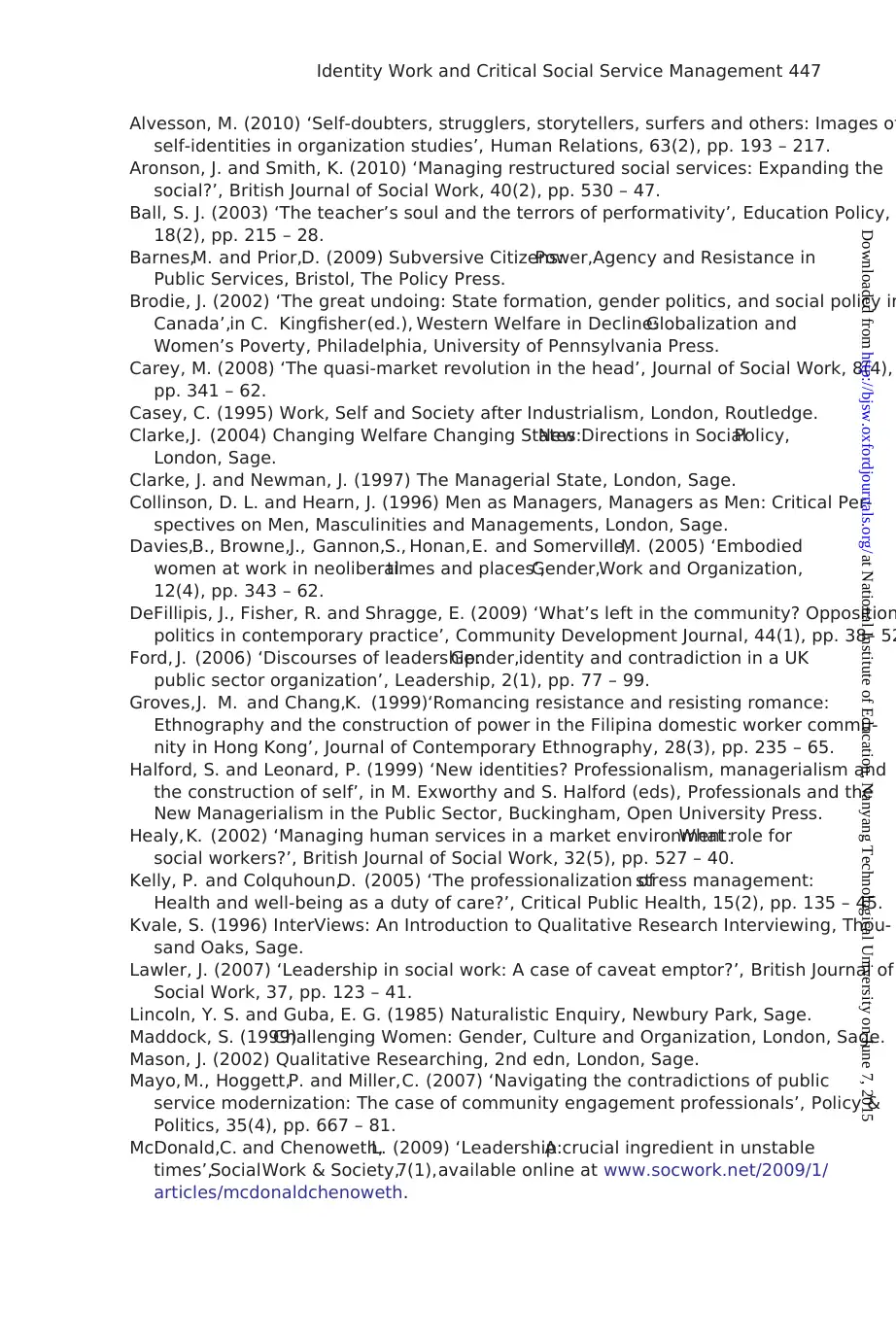
Alvesson, M. (2010) ‘Self-doubters, strugglers, storytellers, surfers and others: Images of
self-identities in organization studies’, Human Relations, 63(2), pp. 193 – 217.
Aronson, J. and Smith, K. (2010) ‘Managing restructured social services: Expanding the
social?’, British Journal of Social Work, 40(2), pp. 530 – 47.
Ball, S. J. (2003) ‘The teacher’s soul and the terrors of performativity’, Education Policy,
18(2), pp. 215 – 28.
Barnes,M. and Prior,D. (2009) Subversive Citizens:Power,Agency and Resistance in
Public Services, Bristol, The Policy Press.
Brodie, J. (2002) ‘The great undoing: State formation, gender politics, and social policy in
Canada’,in C. Kingfisher(ed.), Western Welfare in Decline:Globalization and
Women’s Poverty, Philadelphia, University of Pennsylvania Press.
Carey, M. (2008) ‘The quasi-market revolution in the head’, Journal of Social Work, 8(4),
pp. 341 – 62.
Casey, C. (1995) Work, Self and Society after Industrialism, London, Routledge.
Clarke,J. (2004) Changing Welfare Changing States:New Directions in SocialPolicy,
London, Sage.
Clarke, J. and Newman, J. (1997) The Managerial State, London, Sage.
Collinson, D. L. and Hearn, J. (1996) Men as Managers, Managers as Men: Critical Per-
spectives on Men, Masculinities and Managements, London, Sage.
Davies,B., Browne,J., Gannon,S., Honan,E. and Somerville,M. (2005) ‘Embodied
women at work in neoliberaltimes and places’,Gender,Work and Organization,
12(4), pp. 343 – 62.
DeFillipis, J., Fisher, R. and Shragge, E. (2009) ‘What’s left in the community? Opposition
politics in contemporary practice’, Community Development Journal, 44(1), pp. 38– 52
Ford, J. (2006) ‘Discourses of leadership:Gender,identity and contradiction in a UK
public sector organization’, Leadership, 2(1), pp. 77 – 99.
Groves,J. M. and Chang,K. (1999)‘Romancing resistance and resisting romance:
Ethnography and the construction of power in the Filipina domestic worker commu-
nity in Hong Kong’, Journal of Contemporary Ethnography, 28(3), pp. 235 – 65.
Halford, S. and Leonard, P. (1999) ‘New identities? Professionalism, managerialism and
the construction of self’, in M. Exworthy and S. Halford (eds), Professionals and the
New Managerialism in the Public Sector, Buckingham, Open University Press.
Healy,K. (2002) ‘Managing human services in a market environment:What role for
social workers?’, British Journal of Social Work, 32(5), pp. 527 – 40.
Kelly, P. and Colquhoun,D. (2005) ‘The professionalization ofstress management:
Health and well-being as a duty of care?’, Critical Public Health, 15(2), pp. 135 – 45.
Kvale, S. (1996) InterViews: An Introduction to Qualitative Research Interviewing, Thou-
sand Oaks, Sage.
Lawler, J. (2007) ‘Leadership in social work: A case of caveat emptor?’, British Journal of
Social Work, 37, pp. 123 – 41.
Lincoln, Y. S. and Guba, E. G. (1985) Naturalistic Enquiry, Newbury Park, Sage.
Maddock, S. (1999)Challenging Women: Gender, Culture and Organization, London, Sage.
Mason, J. (2002) Qualitative Researching, 2nd edn, London, Sage.
Mayo, M., Hoggett,P. and Miller,C. (2007) ‘Navigating the contradictions of public
service modernization: The case of community engagement professionals’, Policy &
Politics, 35(4), pp. 667 – 81.
McDonald,C. and Chenoweth,L. (2009) ‘Leadership:A crucial ingredient in unstable
times’,SocialWork & Society,7(1),available online at www.socwork.net/2009/1/
articles/mcdonaldchenoweth.
Identity Work and Critical Social Service Management 447
at National Institute of Education, Nanyang Technological University on June 7, 2015http://bjsw.oxfordjournals.org/Downloaded from
self-identities in organization studies’, Human Relations, 63(2), pp. 193 – 217.
Aronson, J. and Smith, K. (2010) ‘Managing restructured social services: Expanding the
social?’, British Journal of Social Work, 40(2), pp. 530 – 47.
Ball, S. J. (2003) ‘The teacher’s soul and the terrors of performativity’, Education Policy,
18(2), pp. 215 – 28.
Barnes,M. and Prior,D. (2009) Subversive Citizens:Power,Agency and Resistance in
Public Services, Bristol, The Policy Press.
Brodie, J. (2002) ‘The great undoing: State formation, gender politics, and social policy in
Canada’,in C. Kingfisher(ed.), Western Welfare in Decline:Globalization and
Women’s Poverty, Philadelphia, University of Pennsylvania Press.
Carey, M. (2008) ‘The quasi-market revolution in the head’, Journal of Social Work, 8(4),
pp. 341 – 62.
Casey, C. (1995) Work, Self and Society after Industrialism, London, Routledge.
Clarke,J. (2004) Changing Welfare Changing States:New Directions in SocialPolicy,
London, Sage.
Clarke, J. and Newman, J. (1997) The Managerial State, London, Sage.
Collinson, D. L. and Hearn, J. (1996) Men as Managers, Managers as Men: Critical Per-
spectives on Men, Masculinities and Managements, London, Sage.
Davies,B., Browne,J., Gannon,S., Honan,E. and Somerville,M. (2005) ‘Embodied
women at work in neoliberaltimes and places’,Gender,Work and Organization,
12(4), pp. 343 – 62.
DeFillipis, J., Fisher, R. and Shragge, E. (2009) ‘What’s left in the community? Opposition
politics in contemporary practice’, Community Development Journal, 44(1), pp. 38– 52
Ford, J. (2006) ‘Discourses of leadership:Gender,identity and contradiction in a UK
public sector organization’, Leadership, 2(1), pp. 77 – 99.
Groves,J. M. and Chang,K. (1999)‘Romancing resistance and resisting romance:
Ethnography and the construction of power in the Filipina domestic worker commu-
nity in Hong Kong’, Journal of Contemporary Ethnography, 28(3), pp. 235 – 65.
Halford, S. and Leonard, P. (1999) ‘New identities? Professionalism, managerialism and
the construction of self’, in M. Exworthy and S. Halford (eds), Professionals and the
New Managerialism in the Public Sector, Buckingham, Open University Press.
Healy,K. (2002) ‘Managing human services in a market environment:What role for
social workers?’, British Journal of Social Work, 32(5), pp. 527 – 40.
Kelly, P. and Colquhoun,D. (2005) ‘The professionalization ofstress management:
Health and well-being as a duty of care?’, Critical Public Health, 15(2), pp. 135 – 45.
Kvale, S. (1996) InterViews: An Introduction to Qualitative Research Interviewing, Thou-
sand Oaks, Sage.
Lawler, J. (2007) ‘Leadership in social work: A case of caveat emptor?’, British Journal of
Social Work, 37, pp. 123 – 41.
Lincoln, Y. S. and Guba, E. G. (1985) Naturalistic Enquiry, Newbury Park, Sage.
Maddock, S. (1999)Challenging Women: Gender, Culture and Organization, London, Sage.
Mason, J. (2002) Qualitative Researching, 2nd edn, London, Sage.
Mayo, M., Hoggett,P. and Miller,C. (2007) ‘Navigating the contradictions of public
service modernization: The case of community engagement professionals’, Policy &
Politics, 35(4), pp. 667 – 81.
McDonald,C. and Chenoweth,L. (2009) ‘Leadership:A crucial ingredient in unstable
times’,SocialWork & Society,7(1),available online at www.socwork.net/2009/1/
articles/mcdonaldchenoweth.
Identity Work and Critical Social Service Management 447
at National Institute of Education, Nanyang Technological University on June 7, 2015http://bjsw.oxfordjournals.org/Downloaded from
Secure Best Marks with AI Grader
Need help grading? Try our AI Grader for instant feedback on your assignments.
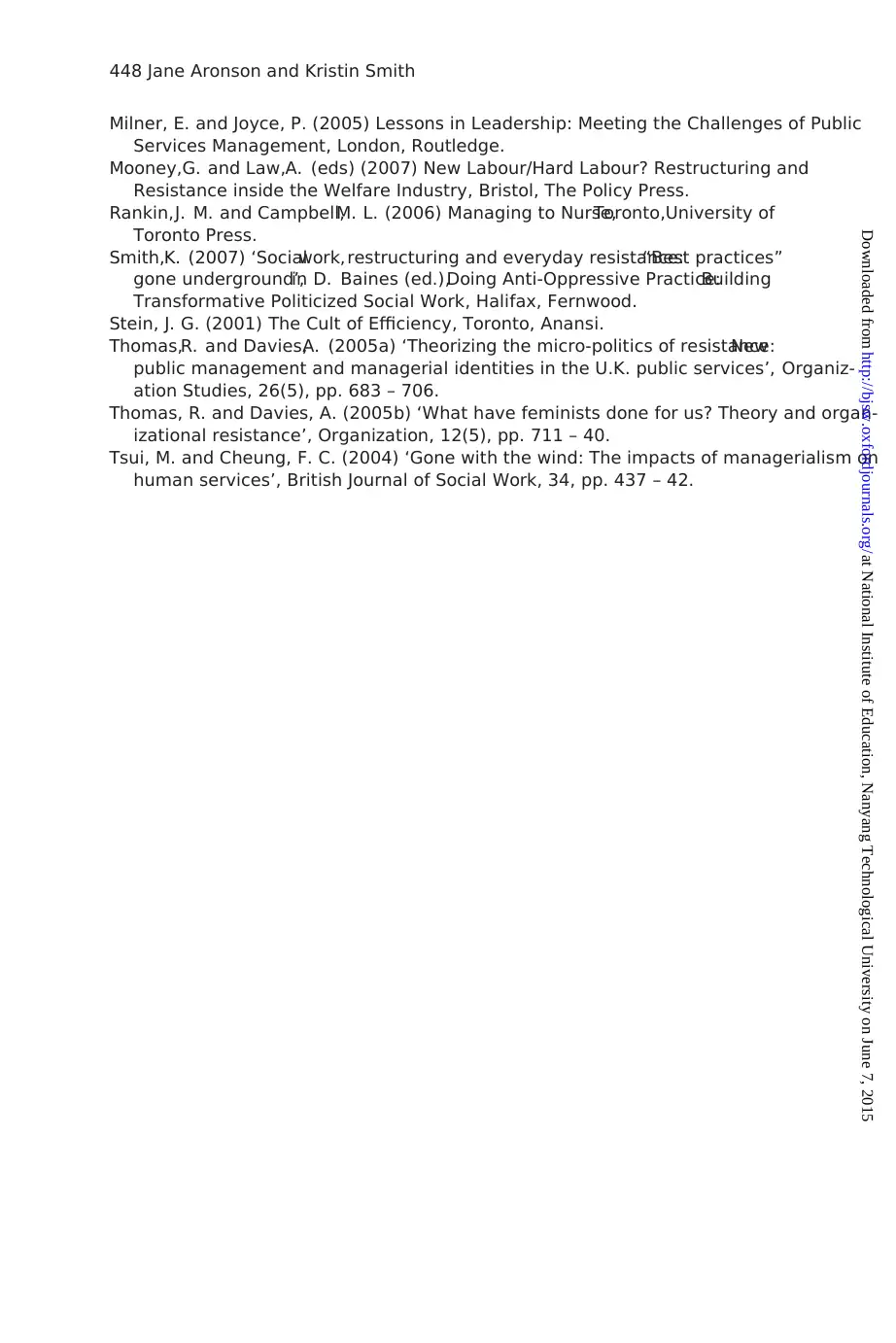
Milner, E. and Joyce, P. (2005) Lessons in Leadership: Meeting the Challenges of Public
Services Management, London, Routledge.
Mooney,G. and Law,A. (eds) (2007) New Labour/Hard Labour? Restructuring and
Resistance inside the Welfare Industry, Bristol, The Policy Press.
Rankin,J. M. and Campbell,M. L. (2006) Managing to Nurse,Toronto,University of
Toronto Press.
Smith,K. (2007) ‘Socialwork,restructuring and everyday resistance:“Best practices”
gone underground’,in D. Baines (ed.),Doing Anti-Oppressive Practice:Building
Transformative Politicized Social Work, Halifax, Fernwood.
Stein, J. G. (2001) The Cult of Efficiency, Toronto, Anansi.
Thomas,R. and Davies,A. (2005a) ‘Theorizing the micro-politics of resistance:New
public management and managerial identities in the U.K. public services’, Organiz-
ation Studies, 26(5), pp. 683 – 706.
Thomas, R. and Davies, A. (2005b) ‘What have feminists done for us? Theory and organ-
izational resistance’, Organization, 12(5), pp. 711 – 40.
Tsui, M. and Cheung, F. C. (2004) ‘Gone with the wind: The impacts of managerialism on
human services’, British Journal of Social Work, 34, pp. 437 – 42.
448 Jane Aronson and Kristin Smith
at National Institute of Education, Nanyang Technological University on June 7, 2015http://bjsw.oxfordjournals.org/Downloaded from
Services Management, London, Routledge.
Mooney,G. and Law,A. (eds) (2007) New Labour/Hard Labour? Restructuring and
Resistance inside the Welfare Industry, Bristol, The Policy Press.
Rankin,J. M. and Campbell,M. L. (2006) Managing to Nurse,Toronto,University of
Toronto Press.
Smith,K. (2007) ‘Socialwork,restructuring and everyday resistance:“Best practices”
gone underground’,in D. Baines (ed.),Doing Anti-Oppressive Practice:Building
Transformative Politicized Social Work, Halifax, Fernwood.
Stein, J. G. (2001) The Cult of Efficiency, Toronto, Anansi.
Thomas,R. and Davies,A. (2005a) ‘Theorizing the micro-politics of resistance:New
public management and managerial identities in the U.K. public services’, Organiz-
ation Studies, 26(5), pp. 683 – 706.
Thomas, R. and Davies, A. (2005b) ‘What have feminists done for us? Theory and organ-
izational resistance’, Organization, 12(5), pp. 711 – 40.
Tsui, M. and Cheung, F. C. (2004) ‘Gone with the wind: The impacts of managerialism on
human services’, British Journal of Social Work, 34, pp. 437 – 42.
448 Jane Aronson and Kristin Smith
at National Institute of Education, Nanyang Technological University on June 7, 2015http://bjsw.oxfordjournals.org/Downloaded from
1 out of 17
Your All-in-One AI-Powered Toolkit for Academic Success.
+13062052269
info@desklib.com
Available 24*7 on WhatsApp / Email
![[object Object]](/_next/static/media/star-bottom.7253800d.svg)
Unlock your academic potential
© 2024 | Zucol Services PVT LTD | All rights reserved.